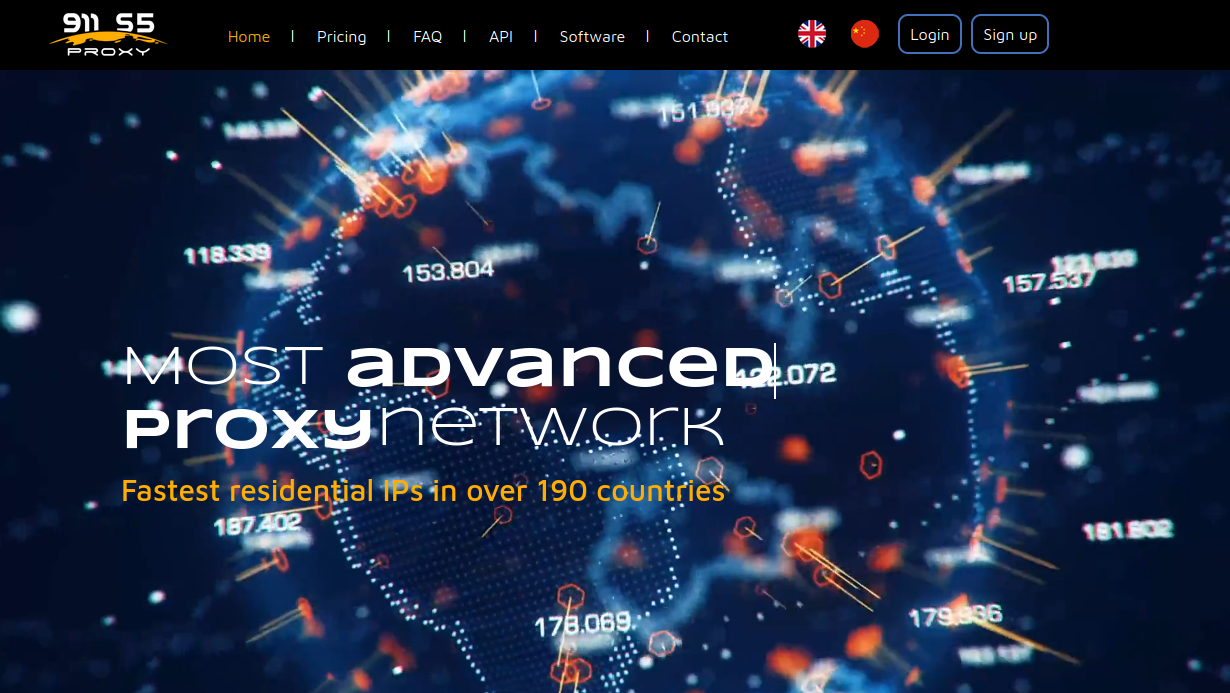
The 911 service as it existed until July 28, 2022.
911[.]re, a proxy service that since 2015 has sold access to hundreds of thousands of Microsoft Windows computers daily, announced this week that it is shutting down in the wake of a data breach that destroyed key components of its business operations. The abrupt closure comes ten days after KrebsOnSecurity published an in-depth look at 911 and its connections to shady pay-per-install affiliate programs that secretly bundled 911’s proxy software with other titles, including “free” utilities and pirated software.
911[.]re is was one of the original “residential proxy” networks, which allow someone to rent a residential IP address to use as a relay for his/her Internet communications, providing anonymity and the advantage of being perceived as a residential user surfing the web.
Residential proxy services are often marketed to people seeking the ability to evade country-specific blocking by the major movie and media streaming providers. But some of them — like 911 — build their networks in part by offering “free VPN” or “free proxy” services that are powered by software which turns the user’s PC into a traffic relay for other users. In this scenario, users indeed get to use a free VPN service, but they are often unaware that doing so will turn their computer into a proxy that lets others use their Internet address to transact online.
From a website’s perspective, the IP traffic of a residential proxy network user appears to originate from the rented residential IP address, not from the proxy service customer. These services can be used in a legitimate manner for several business purposes — such as price comparisons or sales intelligence — but they are massively abused for hiding cybercrime activity because they can make it difficult to trace malicious traffic to its original source.
As noted in KrebsOnSecurity’s July 19 story on 911, the proxy service operated multiple pay-per-install schemes that paid affiliates to surreptitiously bundle the proxy software with other software, continuously generating a steady stream of new proxies for the service.

A cached copy of flashupdate[.]net circa 2016, which shows it was the homepage of a pay-per-install affiliate program that incentivized the silent installation of 911’s proxy software.
Within hours of that story, 911 posted a notice at the top of its site, saying, “We are reviewing our network and adding a series of security measures to prevent misuse of our services. Proxy balance top-up and new user registration are closed. We are reviewing every existing user, to ensure their usage is legit and [in] compliance with our Terms of Service.”
At this announcement, all hell broke loose on various cybercrime forums, where many longtime 911 customers reported they were unable to use the service. Others affected by the outage said it seemed 911 was trying to implement some sort of “know your customer” rules — that maybe 911 was just trying to weed out those customers using the service for high volumes of cybercriminal activity.
Then on July 28, the 911 website began redirecting to a notice saying, “We regret to inform you that we permanently shut down 911 and all its services on July 28th.”
According to 911, the service was hacked in early July, and it was discovered that someone manipulated the balances of a large number of user accounts. 911 said the intruders abused an application programming interface (API) that handles the topping up of accounts when users make financial deposits with the service.
“Not sure how did the hacker get in,” the 911 message reads. “Therefore, we urgently shut down the recharge system, new user registration, and an investigation started.”
However the intruders got in, 911 said, they managed to also overwrite critical 911[.]re servers, data and backups of that data.
“On July 28th, a large number of users reported that they could not log in the system,” the statement continues. “We found that the data on the server was maliciously damaged by the hacker, resulting in the loss of data and backups. Its [sic] confirmed that the recharge system was also hacked the same way. We were forced to make this difficult decision due to the loss of important data that made the service unrecoverable.”
Operated largely out of China, 911 was an enormously popular service across many cybercrime forums, and it became something akin to critical infrastructure for this community after two of 911’s longtime competitors — malware-based proxy services VIP72 and LuxSocks — closed their doors in the past year.
Now, many on the crime forums who relied on 911 for their operations are wondering aloud whether there are any alternatives that match the scale and utility that 911 offered. The consensus seems to be a resounding “no.”
I’m guessing we may soon learn more about the security incidents that caused 911 to implode. And perhaps other proxy services will spring up to meet what appears to be a burgeoning demand for such services at the moment, with comparatively little supply.
In the meantime, 911’s absence may coincide with a measurable (if only short-lived) reprieve in unwanted traffic to top Internet destinations, including banks, retailers and cryptocurrency platforms, as many former customers of the proxy service scramble to make alternative arrangements.
Riley Kilmer, co-founder of the proxy-tracking service Spur.us, said 911’s network will be difficult to replicate in the short run.
“My speculation is [911’s remaining competitors] are going to get a major boost in the short term, but a new player will eventually come along,” Kilmer said. “None of those are good replacements for LuxSocks or 911. However, they will all allow anyone to use them. For fraud rates, the attempts will continue but through these replacement services which should be easier to monitor and stop. 911 had some very clean IP addresses.”
911 wasn’t the only major proxy provider disclosing a breach this week tied to unauthenticated APIs: On July 28, KrebsOnSecurity reported that internal APIs exposed to the web had leaked the customer database for Microleaves, a proxy service that rotates its customers’ IP addresses every five to ten minutes. That investigation showed Microleaves — like 911 — had a long history of using pay-per-install schemes to spread its proxy software.
Microleaves, a ten-year-old proxy service that lets customers route their web traffic through millions of Microsoft Windows computers, recently fixed a vulnerability in their website that exposed their entire user database. Microleaves claims its proxy software is installed with user consent, but data exposed in the breach shows the service has a lengthy history of being supplied with new proxies by affiliates incentivized to distribute the software any which way they can — such as by secretly bundling it with other titles.
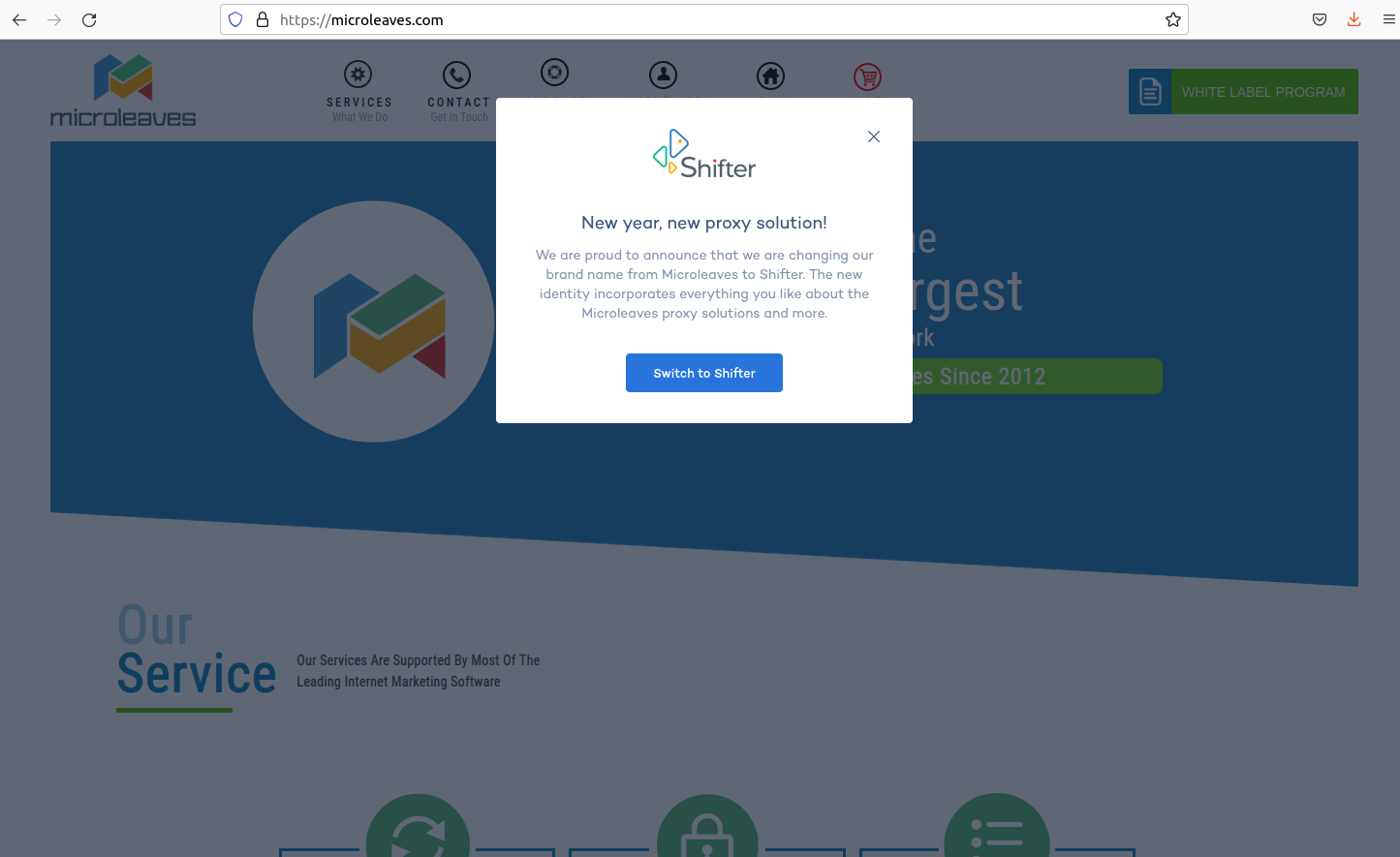
The Microleaves proxy service, which is in the process of being rebranded to Shifter[.[io.
Launched in 2013, Microleaves is a service that allows customers to route their Internet traffic through PCs in virtually any country or city around the globe. Microleaves works by changing each customer’s Internet Protocol (IP) address every five to ten minutes.
The service, which accepts PayPal, Bitcoin and all major credit cards, is aimed primarily at enterprises engaged in repetitive, automated activity that often results in an IP address being temporarily blocked — such as data scraping, or mass-creating new accounts at some service online.
In response to a report about the data exposure from KrebsOnSecurity, Microleaves said it was grateful for being notified about a “very serious issue regarding our customer information.”
Abhishek Gupta is the PR and marketing manager for Microleaves, which he said in the process of being rebranded to “Shifter.io.” Gupta said the report qualified as a “medium” severity security issue in Shifter’s brand new bug bounty program (the site makes no mention of a bug bounty), which he said offers up to $2,000 for reporting data exposure issues like the one they just fixed. KrebsOnSecurity declined the offer and requested that Shifter donate the amount to the Electronic Frontier Foundation (EFF), a digital rights group.
From its inception nearly a decade ago, Microleaves has claimed to lease between 20-30 million IPs via its service at any time. Riley Kilmer, co-founder of the proxy-tracking service Spur.us, said that 20-30 million number might be accurate for Shifter if measured across a six-month time frame. Currently, Spur is tracking roughly a quarter-million proxies associated with Microleaves/Shifter each day, with a high rate of churn in IPs.
Early on, this rather large volume of IP addresses led many to speculate that Microleaves was just a botnet which was being resold as a commercial proxy service.
The very first discussion thread started by the new user Microleaves on the forum BlackHatWorld in 2013 sought forum members who could help test and grow the proxy network. At the time, the Microleaves user said their proxy network had 150,000 IPs globally, and was growing quickly.
One of BlackHatWorld’s moderators asked the administrator of the forum to review the Microleaves post.
“User states has 150k proxies,” the forum skeptic wrote. “No seller on BHW has 150k working daily proxies none of us do. Which hints at a possible BOTNET. That’s the only way you will get 150k.”
Microleaves has long been classified by antivirus companies as adware or as a “potentially unwanted program” (PUP), the euphemism that antivirus companies use to describe executable files that get installed with ambiguous consent at best, and are often part of a bundle of software tied to some “free” download. Security vendor Kaspersky flags the Microleaves family of software as a trojan horse program that commandeers the user’s Internet connection as a proxy without notifying the user.
“While working, these Trojans pose as Microsoft Windows Update,” Kaspersky wrote.
In a February 2014 post to BlackHatWorld, Microleaves announced that its sister service — reverseproxies[.]com — was now offering an “Auto CAPTCHA Solving Service,” which automates the solving of those squiggly and sometimes frustrating puzzles that many websites use to distinguish bots from real visitors. The CAPTCHA service was offered as an add-on to the Microleaves proxy service, and ranged in price from $20 for a 2-day trial to $320 for solving up to 80 captchas simultaneously.
“We break normal Recaptcha with 60-90% success rate, recaptcha with blobs 30% success, and 500+ other captcha,” Microleaves wrote. “As you know all success rate on recaptcha depends very much on good proxies that are fresh and not spammed!”
The exposed Microleaves user database shows that the first user created on the service — username “admin” — used the email address alex.iulian@aol.com. A search on that email address in Constella Intelligence, a service that tracks breached data, reveals it was used to create an account at the link shortening service bit.ly under the name Alexandru Florea, and the username “Acidut.” [Full disclosure: Constella is currently an advertiser on this website].
According to the cyber intelligence company Intel 471, a user named Acidut with the email address iulyan87_4u@gmail.com had an active presence on almost a dozen shadowy money-making and cybercrime forums from 2010 to 2017, including BlackHatWorld, Carder[.]pro, Hackforums, OpenSC, and CPAElites.
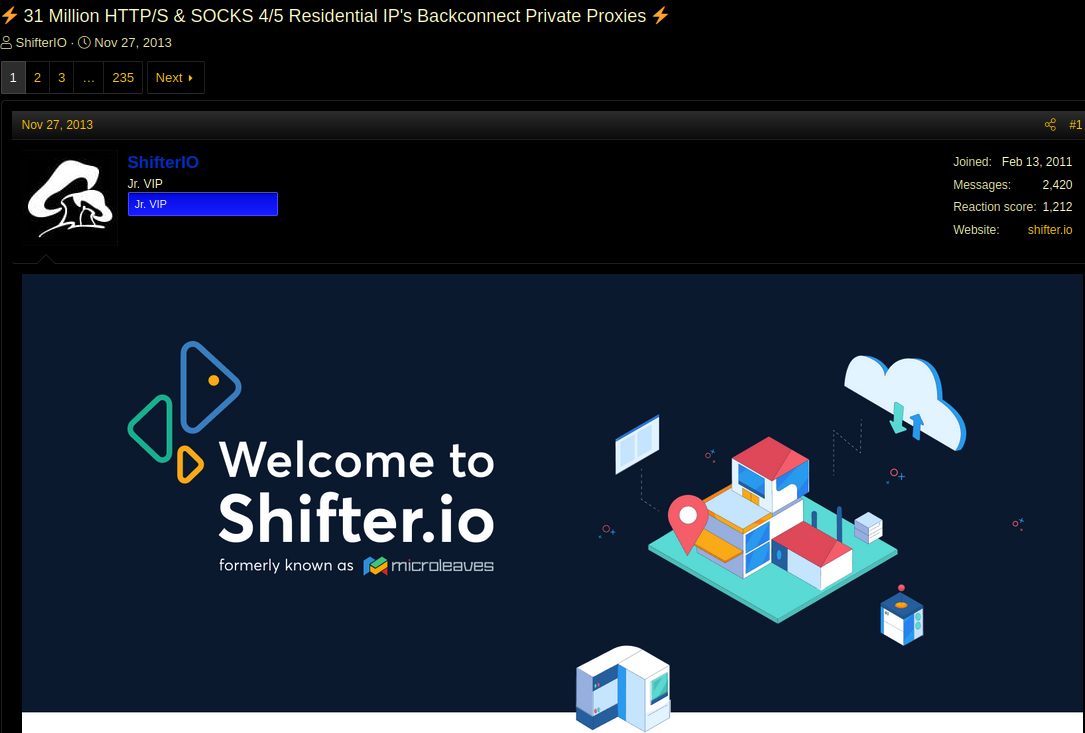
The user Microleaves (later “Shifter.io”) advertised on BlackHatWorld the sale of 31 million residential IPs for use as proxies, in late 2013. The same account continues to sell subscriptions to Shifter.io.
In a 2011 post on Hackforums, Acidut said they were building a botnet using an “exploit kit,” a set of browser exploits made to be stitched into hacked websites and foist malware on visitors. Acidut claimed their exploit kit was generating 3,000 to 5,000 new bots each day. OpenSC was hacked at one point, and its private messages show Acidut purchased a license from Exmanoize, the handle used by the creator of the Eleonore Exploit Kit.
By November 2013, Acidut was advertising the sale of “26 million SOCKS residential proxies.” In a March 2016 post to CPAElites, Acidut said they had a worthwhile offer for people involved in pay-per-install or “PPI” schemes, which match criminal gangs who pay for malware installs with enterprising hackers looking to sell access to compromised PCs and websites.
Because pay-per-install affiliate schemes rarely impose restrictions on how the software can be installed, such programs can be appealing for cybercriminals who already control large collections of hacked machines and/or compromised websites. Indeed, Acidut went a step further, adding that their program could be quietly and invisibly nested inside of other programs.
“For those of you who are doing PPI I have a global offer that you can bundle to your installer,” Acidut wrote. “I am looking for many installs for an app that will generate website visits. The installer has a silence version which you can use inside your installer. I am looking to buy as many daily installs as possible worldwide, except China.”
Asked about the source of their proxies in 2014, the Microleaves user responded that it was “something related to a PPI network. I can’t say more and I won’t get into details.”
Acidut authored a similar message on the forum BlackHatWorld in 2013, where they encouraged users to contact them on Skype at the username “nevo.julian.” That same Skype contact address was listed prominently on the Microleaves homepage up until about a week ago when KrebsOnSecurity first reached out to the company.
There is a Facebook profile for an Alexandru Iulian Florea from Constanta, Romania, whose username on the social media network is Acidut. Prior to KrebsOnSecurity alerting Shifter of its data breach, the Acidut profile page associated Florea with the websites microleaves.com, shrooms.io, leftclick[.]io, and online[.]io. Mr. Florea did not respond to multiple requests for comment, and his Facebook page no longer mentions these domains.
Leftclick and online[.]io emerged as subsidiaries of Microleaves between 2017 and 2018. According to a help wanted ad posted in 2018 for a developer position at online[.]io, the company’s services were brazenly pitched to investors as “a cybersecurity and privacy tool kit, offering extensive protection using advanced adblocking, anti-tracking systems, malware protection, and revolutionary VPN access based on residential IPs.”

A teaser from Irish Tech News.
“Online[.]io is developing the first fully decentralized peer-to-peer networking technology and revolutionizing the browsing experience by making it faster, ad free, more reliable, secure and non-trackable, thus freeing the Internet from annoying ads, malware, and trackers,” reads the rest of that help wanted ad.
Microleaves CEO Alexandru Florea gave an “interview” to the website Irishtechnews.ie in 2018, in which he explained how Online[.]io (OIO) was going to upend the online advertising and security industries with its initial coin offering (ICO). The word interview is in air quotes because the following statements by Florea deserved some serious pushback by the interviewer.
“Online[.]io solution, developed using the Ethereum blockchain, aims at disrupting the digital advertising market valued at more than $1 trillion USD,” Alexandru enthused. “By staking OIO tokens and implementing our solution, the website operators will be able to access a new non-invasive revenue stream, which capitalizes on time spent by users online.”
“At the same time, internet users who stake OIO tokens will have the opportunity to monetize on the time spent online by themselves and their peers on the World Wide Web,” he continued. “The time spent by users online will lead to ICE tokens being mined, which in turn can be used in the dedicated merchant system or traded on exchanges and consequently changed to fiat.”
Translation: If you install our proxy bot/CAPTCHA-solver/ad software on your computer — or as an exploit kit on your website — we’ll make millions hijacking ads and you will be rewarded with heaps of soon-to-be-worthless shitcoin. Oh, and all your security woes will disappear, too.
It’s unclear how many Internet users and websites willingly agreed to get bombarded with Online[.]io’s annoying ads and search hijackers — and to have their PC turned into a proxy or CAPTCHA-solving zombie for others. But that is exactly what multiple security companies said happened when users encountered online[.]io, which operated using the Microsoft Windows process name of “online-guardian.exe.”
Incredibly, Crunchbase says Online[.]io raised $6 million in funding for an initial coin offering in 2018, based on the plainly ludicrous claims made above. Since then, however, online[.]io seems to have gone…offline, for good.
Until this week, Shifter.io’s website also exposed information about its customer base and most active users, as well as how much money each client has paid over the lifetime of their subscription. The data indicates Shifter has earned more than $11.7 million in direct payments, although it’s unclear how far back in time those payment records go, or how complete they are.
The bulk of Shifter customers who spent more than $100,000 at the proxy service appear to be digital advertising companies, including some located in the United States. None of the several Shifter customers approached by KrebsOnSecurity agreed to be interviewed.
Shifter’s Gupta said he’d been with the company for three years, since the new owner took over the company and made the rebrand to Shifter.
“The company has been on the market for a long time, but operated under a different brand called Microleaves, until new ownership and management took over the company started a reorganization process that is still on-going,” Gupta said. “We are fully transparent. Mostly [our customers] work in the data scraping niche, this is why we actually developed more products in this zone and made a big shift towards APIs and integrated solutions in the past year.”
Ah yes, the same APIs and integrated solutions that were found exposed to the Internet and leaking all of Shifter’s customer information.
Gupta said the original founder of Microleaves was a man from India, who later sold the business to Florea. According to Gupta, the Romanian entrepreneur had multiple issues in trying to run the company, and then sold it three years ago to the current owner — Super Tech Ventures, a private equity company based in Taiwan.
“Our CEO is Wang Wei, he has been with the company since 3 years ago,” Gupta said. “Mr. Florea left the company two years ago after ending this transition period.”
Google and other search engines seem to know nothing about a Super Tech Ventures based in Taiwan. Incredibly, Shifter’s own PR person claimed that he, too, was in the dark on this subject.
“I would love to help, but I really don’t know much about the mother company,” Gupta said, essentially walking back his “fully transparent” statement. “I know they are a branch of the bigger group of asian investment firms focused on private equity in multiple industries.”
Adware and proxy software are often bundled together with “free” software utilities online, or with popular software titles that have been pirated and quietly fused with installers tied to various PPI affiliate schemes.
But just as often, these intrusive programs will include some type of notice — even if installed as part of a software bundle — that many users simply do not read and click “Next” to get on with installing whatever software they’re seeking to use. In these cases, selecting the “basic” or “default” settings while installing usually hides any per-program installation prompts, and assumes you agree to all of the bundled programs being installed. It’s always best to opt for the “custom” installation mode, which can give you a better idea of what is actually being installed, and can let you control certain aspects of the installation.
Either way, it’s best to start with the assumption that if a software or service online is “free,” that there is likely some component involved that allows the provider of that service to monetize your activity. As KrebsOnSecurity noted at the conclusion of last week’s story on a China-based proxy service called 911, the rule of thumb for transacting online is that if you’re not the paying customer, then you and/or your devices are probably the product that’s being sold to others.
Further reading on proxy services:
July 18, 2022: A Deep Dive Into the Residential Proxy Service ‘911’
June 28, 2022: The Link Between AWM Proxy & the Glupteba Botnet
June 22, 2022: Meet the Administrators of the RSOCKS Proxy Botnet
Sept. 1, 2021: 15-Year-Old Malware Proxy Network VIP72 Goes Dark
Aug. 19, 2019: The Rise of “Bulletproof” Residential Networks
It’s been seven years since the online cheating site AshleyMadison.com was hacked and highly sensitive data about its users posted online. The leak led to the public shaming and extortion of many Ashley Madison users, and to at least two suicides. To date, little is publicly known about the perpetrators or the true motivation for the attack. But a recent review of Ashley Madison mentions across Russian cybercrime forums and far-right websites in the months leading up to the hack revealed some previously unreported details that may deserve further scrutiny.
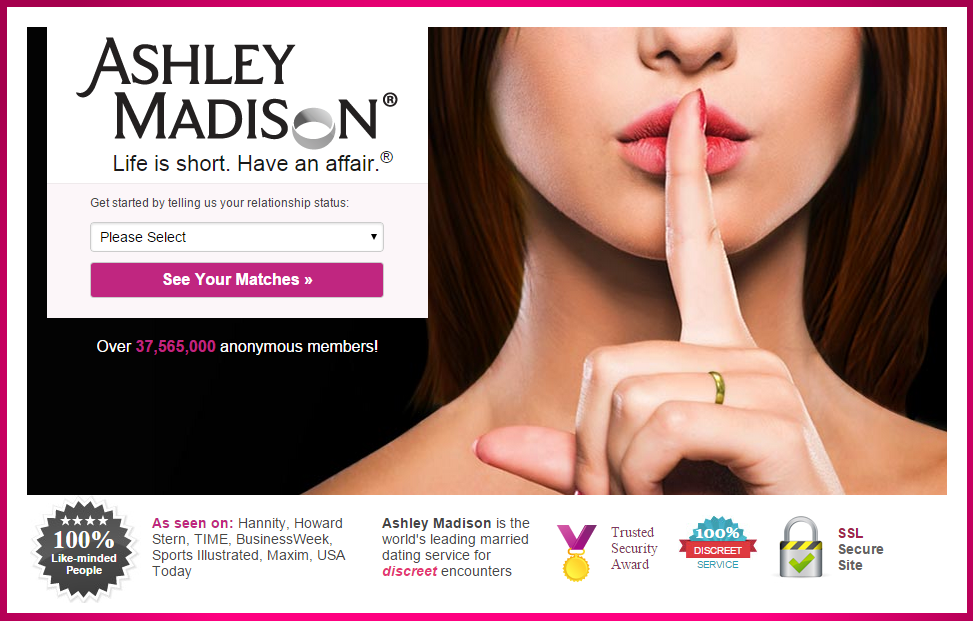
As first reported by KrebsOnSecurity on July 19, 2015, a group calling itself the “Impact Team” released data sampled from millions of users, as well as maps of internal company servers, employee network account information, company bank details and salary information.
The Impact Team said it decided to publish the information because ALM “profits on the pain of others,” and in response to a paid “full delete” service Ashley Madison parent firm Avid Life Media offered that allowed members to completely erase their profile information for a $19 fee.
According to the hackers, although the delete feature promised “removal of site usage history and personally identifiable information from the site,” users’ purchase details — including real name and address — weren’t actually scrubbed.
“Full Delete netted ALM $1.7mm in revenue in 2014. It’s also a complete lie,” the hacking group wrote. “Users almost always pay with credit card; their purchase details are not removed as promised, and include real name and address, which is of course the most important information the users want removed.”

A snippet of the message left behind by the Impact Team.
The Impact Team said ALM had one month to take Ashley Madison offline, along with a sister property called Established Men. The hackers promised that if a month passed and the company did not capitulate, it would release “all customer records, including profiles with all the customers’ secret sexual fantasies and matching credit card transactions, real names and addresses, and employee documents and emails.”
Exactly 30 days later, on Aug. 18, 2015, the Impact Team posted a “Time’s up!” message online, along with links to 60 gigabytes of Ashley Madison user data.
One aspect of the Ashley Madison breach that’s always bothered me is how the perpetrators largely cast themselves as fighting a crooked company that broke their privacy promises, and how this narrative was sustained at least until the Impact Team decided to leak all of the stolen user account data in August 2015.
Granted, ALM had a lot to answer for. For starters, after the breach it became clear that a great many of the female Ashley Madison profiles were either bots or created once and never used again. Experts combing through the leaked user data determined that fewer than one percent of the female profiles on Ashley Madison had been used on a regular basis, and the rest were used just once — on the day they were created. On top of that, researchers found 84 percent of the profiles were male.
But the Impact Team had to know that ALM would never comply with their demands to dismantle Ashley Madison and Established Men. In 2014, ALM reported revenues of $115 million. There was little chance the company was going to shut down some of its biggest money machines.
Hence, it appears the Impact Team’s goal all along was to create prodigious amounts of drama and tension by announcing the hack of a major cheating website, and then letting that drama play out over the next few months as millions of exposed Ashley Madison users freaked out and became the targets of extortion attacks and public shaming.
Robert Graham, CEO of Errata Security, penned a blog post in 2015 concluding that the moral outrage professed by the Impact Team was pure posturing.
“They appear to be motivated by the immorality of adultery, but in all probability, their motivation is that #1 it’s fun and #2 because they can,” Graham wrote.
Per Thorsheim, a security researcher in Norway, told Wired at the time that he believed the Impact Team was motivated by an urge to destroy ALM with as much aggression as they could muster.
“It’s not just for the fun and ‘because we can,’ nor is it just what I would call ‘moralistic fundamentalism,'” Thorsheim told Wired. “Given that the company had been moving toward an IPO right before the hack went public, the timing of the data leaks was likely no coincidence.”
As the seventh anniversary of the Ashley Madison hack rolled around, KrebsOnSecurity went back and looked for any mentions of Ashley Madison or ALM on cybercrime forums in the months leading up to the Impact Team’s initial announcement of the breach on July 19, 2015. There wasn’t much, except a Russian guy offering to sell payment and contact information on 32 million AshleyMadison users, and a bunch of Nazis upset about a successful Jewish CEO promoting adultery.

Cyber intelligence firm Intel 471 recorded a series of posts by a user with the handle “Brutium” on the Russian-language cybercrime forum Antichat between 2014 and 2016. Brutium routinely advertised the sale of large, hacked databases, and on Jan. 24, 2015, this user posted a thread offering to sell data on 32 million Ashley Madison users:
“Data from July 2015
Total ~32 Million contacts:
full name; email; phone numbers; payment, etc.”
It’s unclear whether the postdated “July 2015” statement was a typo, or if Brutium updated that sales thread at some point. There is also no indication whether anyone purchased the information. Brutium’s profile has since been removed from the Antichat forum.
Flashpoint is a threat intelligence company in New York City that keeps tabs on hundreds of cybercrime forums, as well as extremist and hate websites. A search in Flashpoint for mentions of Ashley Madison or ALM prior to July 19, 2015 shows that in the six months leading up to the hack, Ashley Madison and its then-CEO Noel Biderman became a frequent subject of derision across multiple neo-Nazi websites.
On Jan. 14, 2015, a member of the neo-Nazi forum Stormfront posted a lively thread about Ashley Madison in the general discussion area titled, “Jewish owned dating website promoting adultery.”
On July 3, 2015, Andrew Anglin, the editor of the alt-right publication Daily Stormer, posted excerpts about Biderman from a story titled, “Jewish Hyper-Sexualization of Western Culture,” which referred to Biderman as the “Jewish King of Infidelity.”
On July 10, a mocking montage of Biderman photos with racist captions was posted to the extremist website Vanguard News Network, as part of a thread called “Jews normalize sexual perversion.”
“Biderman himself says he’s a happily married father of two and does not cheat,” reads the story posted by Anglin on the Daily Stormer. “In an interview with the ‘Current Affair’ program in Australia, he admitted that if he found out his own wife was accessing his cheater’s site, ‘I would be devastated.'”
The leaked AshleyMadison data included more than three years’ worth of emails stolen from Biderman. The hackers told Motherboard in 2015 they had 300 GB worth of employee emails, but that they saw no need to dump the inboxes of other company employees.
Several media outlets pounced on salacious exchanges in Biderman’s emails as proof he had carried on multiple affairs. Biderman resigned as CEO on Aug. 28, 2015. The last message in the archive of Biderman’s stolen emails was dated July 7, 2015 — almost two weeks before the Impact Team would announce their hack.
Biderman told KrebsOnSecurity on July 19, 2015 that the company believed the hacker was some type of insider.
“We’re on the doorstep of [confirming] who we believe is the culprit, and unfortunately that may have triggered this mass publication,” Biderman said. “I’ve got their profile right in front of me, all their work credentials. It was definitely a person here that was not an employee but certainly had touched our technical services.”
Certain language in the Impact Team’s manifesto seemed to support this theory, such as the line: “For a company whose main promise is secrecy, it’s like you didn’t even try, like you thought you had never pissed anyone off.”
But despite ALM offering a belated $500,000 reward for information leading to the arrest and conviction of those responsible, to this day no one has been charged in connection with the hack.
We’ve all seen the headlines like “race to the cloud” and “cloud-first.” These articles and publications are true, more and more customers have adopted cloud strategies, but there is more to the story. In these customer conversations, cloud security and network security are often discussed in unison. Why is that?
Customers desire freedom and choice when establishing resilience across every aspect of their business, and this requires both the ability to remain agile, and maintain control of their organization’s most sensitive data. Neither of these can be achieved with just the cloud, or private data center. Organizations are investing in hybrid-multicloud environments to ensure continuity amidst unpredictable threats and change. But these investments will fall short if they do not include security.
The modern enterprise relies on the network more than ever before, and it looks a lot different than it did 10 years ago. According to our 2022 Global Hybrid Cloud Trends Report, where 2,500 global IT leaders were interviewed across 13 countries, 82% said they have adopted hybrid cloud architectures, and 47% of organizations use between two and three public IaaS clouds1. As organizations have grown more dependent on the network, the more complex it has become, making firewall capabilities the most critical element of the hybrid-multicloud security strategy. And Cisco has a firewall capability for every strategy, protecting your most important assets no matter where you choose to deploy it.
In May, Cisco brought offerings from Umbrella and Duo to the AWS Marketplace. Today at AWS Re:Inforce, Cisco Secure announced furthering its partnership with AWS to drive innovation with the goal to protect the integrity of your business. Validating our commitment to hybrid-multicloud security, Cisco has received the AWS Security Competency Partner designation for Network and Infrastructure Security. This designation was awarded through our demonstrated success with customer engagements and rigorous technical validations of Secure Firewall.
This week at AWS Re:Inforce, customers can stop by our booth to see our latest firewall innovation. Cisco Secure Firewall as-a-service on AWS builds on our existing portfolio, giving organizations greater flexibility and choice with a radically simplified SaaS offering. If organizations are truly to embrace security across the multi-environment IT, customers demand simplification without compromising security. With a SaaS-based form factor, management and deployment complexity is reduced. NetOps and SecOps teams will enjoy a simplified security architecture where provisioning of firewalls and control plane infrastructure are managed by Cisco. This will save your teams time by removing the need to rearchitect the network, freeing them to focus on protecting the integrity of your business.
As organizations continue to move more of their day-to-day operations to the cloud, Cisco and AWS are committed to ensure that security is an integral part of their hybrid multi-cloud strategy. We all have seen the impact of security that is bolted on, or too complex. If we are truly to find that balance between agility and protection to ensure business continuity, we need to ensure the same protections we have in the private infrastructure are easily consumed no matter where your data may roam.
Product page: Cisco Secure Firewall for Public Cloud
Partner page: Cisco solutions on AWS
Blog: Securing cloud is everyone’s responsibility
Quick Start page: Cisco solutions on AWS
Amazon Partner Network page: Cisco solutions on AWS
2022 Global Hybrid Cloud Trends Report
1 Henderson, N. & Hanselman, E. (2022, May 25). 2022 Global Hybrid Cloud Trends Report.
S&P Global Market Intelligence, commissioned by Cisco Systems.
https://www.cisco.com/c/en/us/solutions/hybrid-cloud/2022-trends.html ‘
We’d love to hear what you think. Ask a Question, Comment Below, and Stay Connected with Cisco Secure on social!
Cisco Secure Social Channels
We have entered a world where uncertainty has become the normal operating mode for everyone. Within this new frontier, cybersecurity has become even more challenging. However, some cybersecurity professionals have stood out, using their unique skills and resourcefulness to protect the integrity of their businesses, and to withstand unpredictable and dynamically changing threats. In the end, they, and their businesses have emerged even stronger.
These accomplishments have lead them to be selected from over more than 700 Cisco Cybersecurity Advocates – who are also members of Cisco Insider Advocates – to join the League of Cybersecurity Heroes.
Cisco Insider Advocates is a peer networking community developed several years ago for Cisco customers around the globe. Currently, over 14,000 customers are using it to share technology insights, feedback, and best practices, and also to make meaningful connections with others in the industry. We at Cisco believe that when we connect, anything is possible, and the Insider Advocacy program is a great example of the great things that can happen when people come together.
As the global CISO of Mediapro, Roberto has deployed Cisco SecureX together with Umbrella, Secure Endpoint, Secure Firewall, ISE, NGIP, Threat Response, AnyConnect, and Web security. With this partnership, Mediapro has reduced its threat detection time by 90%. In addition, they have seen no false positives in their threat detection alerts. It is rare to boast of a 100% success rate, but they can boldly make that pronouncement. All of this has also benefitted Mediapro financially by incurring zero fines for any compliance issues
What do music, cybersecurity, and teaching all have in common? They all culminate in a readiness to perform. Equally, they all require collaboration, comfort with the unexpected, and a passion for the job. Blair exemplifies the best of these traits, and in doing so, he provides inspiration and excellence to all with whom he interacts. Watching Blair at work makes one wonder if there are more hours granted to him during a day than the average person. He is a time-maximizer, spending most of that time in the service of others.
Too often, cybersecurity certifications are treated derisively by some of the very professionals who need them most. This is not the case with Kevin, who can list the many benefits of attaining certifications. Kevin’s desire to improve his knowledge doesn’t stop with technology and cybersecurity. He is an avid reader of anything that can raise him up to be better than he was the day before. With a career that started in the US Marine Corps, Kevin continues to learn and grow, all the while remaining as masterful at a computer keyboard as he is his with his traditional 55-gallon-barrel BBQ smoker and grill.
Steve is a Senior Cybersecurity and Network Architect at Lake Trust Credit Union. Like most organizations, Lake Trust has had to transition to a completely remote workforce quickly, and thanks to Secure Network Analytics, they were able to transition the employees to work remotely while maintaining the same high level of visibility and protection in place. Steve was the subject of a case study about the benefits that Cisco products have brought to Lake Trust Credit Unions’ customers. He is currently collaborating to update that information to share more of his knowledge.
Being the Head of Information Technology is never an easy job. However, when food manufacturer, Leng-d’Or, was faced with a challenge during the pandemic that could have interrupted its production line, quick thinking, skilled leadership, and a close partnership with Cisco all lead to positive outcomes, and helped them to pull through stronger than before. Part of this success comes from Enric’s distinct understanding of the threats, solutions, and processes needed to bring security to a higher level for the Leng-d’Or organization. Enric also shares his success story very freely, adding immeasurable benefits to the security community.
Cybersecurity is truly a global discipline. Tony Dous proves this by practicing his craft as a Senior Network Security Engineer in Cairo, Egypt. Tony’s involvement with the Cisco community shows how no distance is too far for a motivated cybersecurity professional.
When John Patrick is on the job, there is no longer any feeling that the criminals are one-step ahead of the good guys. He adopted Umbrella together with Meraki to develop a proactive security approach inside his organization. John Patrick created a more unified network from a patchwork of disparate entities. In doing so, he reduced the complexity within the environment. Complexity is so often responsible for security gaps, and John Patrick’s work not only corrected those gaps, but he brought people together in the process. He and his team received great feedback from the employees, who enjoyed a consistent network experience.
We often hear stories about teenagers who become enamored with technology, leading to the fulfillment of a dream. Amit Gumber became interested in cybersecurity at an early age, pursued his passion and has worked in the field ever since. His sense of advocacy is best described in his own words: “I’m quite passionate about sharing knowledge and ideas with peers and participating in collaborative activities.” Amit’s use of Cisco technologies has helped HCL Technologies to stabilize and secure their environment.
One of the most important factors for success is insatiable curiosity. Mark Healey is a continuous learner, and he is an example of someone who enthusiastically shares his knowledge. Whether it is on a personal level, or through his high engagement as part of the Cisco Insider Advocates community, or as an active member of the Internet Society, Mark is an evangelist and a positive voice for cybersecurity.
Wouter holds a special designation, not only as a member of the League of Cybersecurity Heroes, but also as the recipient of the “Cybersecurity Defender of the Year” award. Wouter is an active participant in the cybersecurity community, working with an almost evangelical zeal towards sharing the importance of holistic cybersecurity. His contributions stand out towards making the cyber realm a safer place.
It is often said that the job of a cybersecurity professional in an educational facility is especially challenging. When that facility happens to be the largest in an entire country, with over 4,000 schools and universities, the job of protecting it can seem insurmountable. At AzEduNet, in Azerbaijan, Bahruz and his team is tasked with securing the network for its 1.5 Million students. With Cisco Secure, the security team reduced security incidents by 80%. This not only ensures access for the students, but also keeps the data safe.
Many people want to enter the cybersecurity profession, but few have the dedication and perseverance to fully embrace the skillset required to meet that goal. Walther Noel not only had the desire to refocus his career, but he proved it by earning the CyberOps Associate Certification. His accomplishment is a prime example of how one can step outside of their comfort zone to grow and thrive.
Pascual demonstrates how important it is to make the most of the learning opportunities in Cisco Insiders Advocates. While already a successful NOC engineer, he sought to advance his professional development by studying cybersecurity. He passed the CCNA CyberOps 200-201 exam, moving him closer to propelling his career to even higher achievements.
One of the noblest expressions of knowledge is the desire to freely share that information. Inderdeep lives up to this ideal, offering his expertise to all with no expectations of reciprocity. His charitable spirit has not gone unnoticed, as he has been a previous award winner for Cisco IT Blogs, as well as a designation on the Feedspot top 100 Networking Blog.
Being the first to try a new technology can be a risky proposition. However, as a COO, risk calculations are in one’s blood. Luigi, along with the Sara Assicurazioni organization, hails as the first company in Italy to embrace cloud technology. As a company with more than one million customers, this was a bold initiative that required careful planning, keen insight, and above all, collaboration. In the end, this has resulted not only in a digital transformation, but a business transformation.
Whether it is a technical achievement, a personal triumph, or a spirit of helping others, each member of our League of Cybersecurity Heroes proves how technology and humanity can work together to accomplish the impossible. Congratulations to all of them!
We’d love to hear what you think. Ask a Question, Comment Below, and Stay Connected with Cisco Secure on social!
Cisco Secure Social Channels
Instagram
Facebook
Twitter
LinkedIn

Ever hear of a crime called skimming? It may not be as dramatic a crime as assault or Ponzi schemes, but it can cause significant problems to you as your savings account can be wiped out in a flash.
Picture a scrawny nerd tampering with an automated teller machine (ATM)—the machine you use with your debit card to get cash. The thief places a device over the slot through which you slide your debit card. You have no idea it’s there. You swipe your card, and the device “skims” or reads your card’s information. In the middle of the night, the thief creeps back, removes the skimming device, downloads your data, burns it to a blank ATM card, makes a fat withdrawal and goes home with the loot. Or they could download your information from the skimmer and then use your information to make online purchases or access your account. Either way, they could clean you out before you wake up next morning!
Now, to be successful, the criminal not only needs a skimming device, they also need to attach a tiny wireless camera to capture your PIN. These cameras are usually concealed in the lighting fixture above the keypad, in a brochure near the machine, or attached directly to the ATM.
To protect yourself from being skimmed, and generally staying safe when using your debit or credit cards, follow these tips:
Stay safe from skimming!
The post What is ATM Skimming? appeared first on McAfee Blog.

The 911 service as it exists today.
For the past seven years, an online service known as 911 has sold access to hundreds of thousands of Microsoft Windows computers daily, allowing customers to route their Internet traffic through PCs in virtually any country or city around the globe — but predominantly in the United States. 911 says its network is made up entirely of users who voluntarily install its “free VPN” software. But new research shows the proxy service has a long history of purchasing installations via shady “pay-per-install” affiliate marketing schemes, some of which 911 operated on its own.
911[.]re is one of the original “residential proxy” networks, which allow someone to rent a residential IP address to use as a relay for his/her Internet communications, providing anonymity and the advantage of being perceived as a residential user surfing the web.
From a website’s perspective, the IP traffic of a residential proxy network user appears to originate from the rented residential IP address, not from the proxy service customer. These services can be used in a legitimate manner for several business purposes — such as price comparisons or sales intelligence — but they are massively abused for hiding cybercrime activity because they can make it difficult to trace malicious traffic to its original source.
Residential proxy services are often marketed to people seeking the ability to evade country-specific blocking by the major movie and media streaming providers. But some of them — like 911 — build their networks in part by offering “free VPN” or “free proxy” services that are powered by software which turns the user’s PC into a traffic relay for other users. In this scenario, users indeed get to use a free VPN service, but they are often unaware that doing so will turn their computer into a proxy that lets others use their Internet address to transact online.
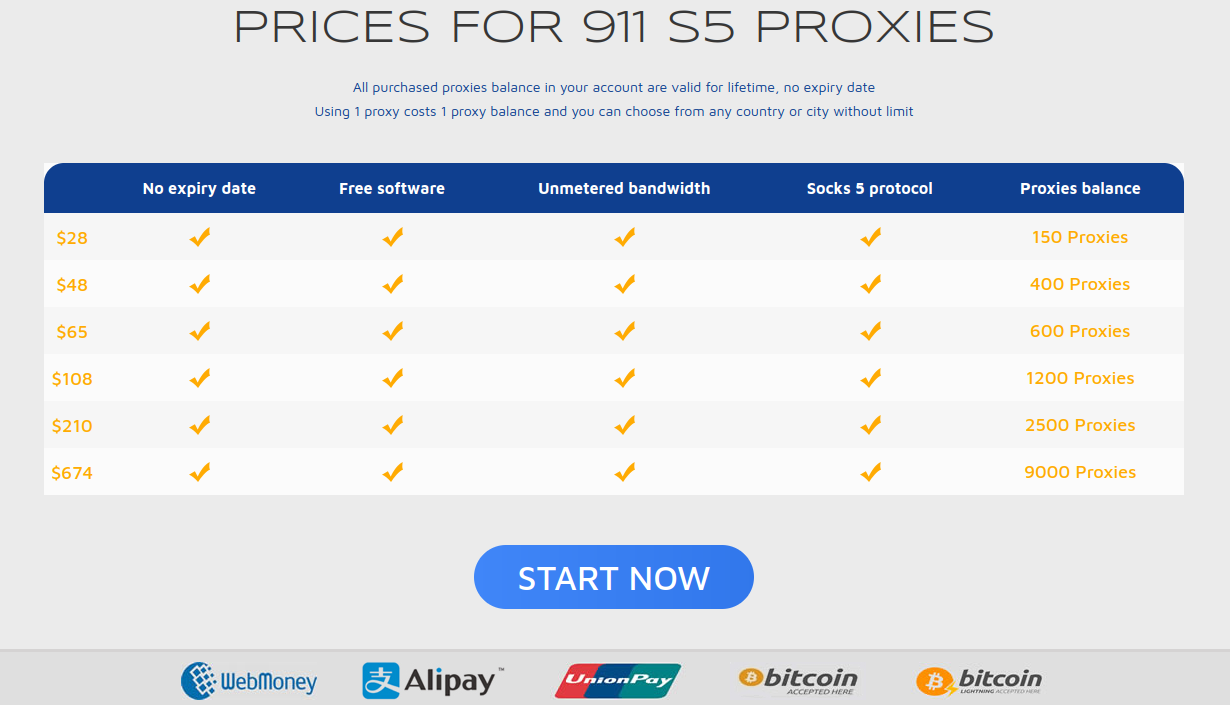
The current prices for 911’s proxies.
Researchers at the University of Sherbrooke in Canada recently published an analysis of 911, and found there were roughly 120,000 PCs for rent via the service, with the largest number of them located in the United States.
“The 911[.]re network uses at least two free VPN services to lure its users to install a malware-like software that achieves persistence on the user’s computer,” the researchers wrote. “During the research we identified two free VPN services that [use] a subterfuge to lure users to install software that looks legitimate but makes them part of the network. These two software are currently unknown to most if not all antivirus companies.”
The researchers concluded that 911 is supported by a “mid scale botnet-like infrastructure that operates in several networks, such as corporate, government and critical infrastructure.” The Canadian team said they found many of the 911 nodes available for rent were situated within several major US-based universities and colleges, critical infrastructures such as clean water, defense contractors, law enforcement and government networks.
Highlighting the risk that 911 nodes could pose to internal corporate networks, they observed that “the infection of a node enables the 911.re user to access shared resources on the network such as local intranet portals or other services.”
“It also enables the end user to probe the LAN network of the infected node,” the paper continues. “Using the internal router, it would be possible to poison the DNS cache of the LAN router of the infected node, enabling further attacks.”
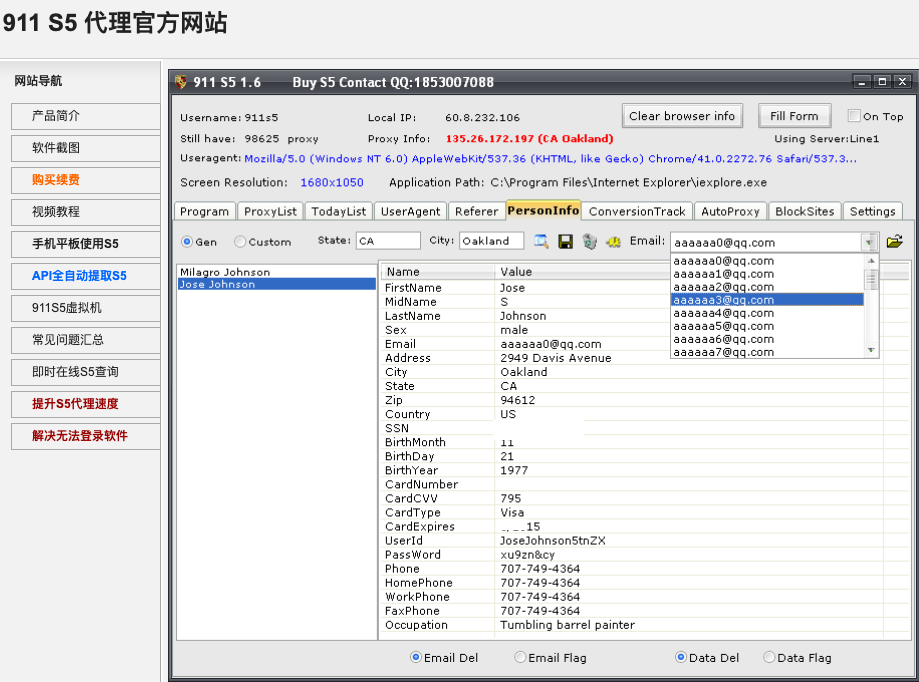
The 911 user interface, as it existed when the service first launched in 2016.
A review of the clues left behind by 911’s early days on the Internet paint a more complete picture of this long-running proxy network. The domain names used by 911 over the years have a few common elements in their original WHOIS registration records, including the address ustraffic@qq.com and a Yunhe Wang from Beijing.
That ustraffic email is tied to a small number of interesting domains, including browsingguard[.]com, cleantraffic[.]net, execlean[.]net, proxygate[.]net, and flashupdate[.]net.
A cached copy of flashupdate[.]net available at the Wayback Machine shows that in 2016 this domain was used for the “ExE Bucks” affiliate program, a pay-per-install business which catered to people already running large collections of hacked computers or compromised websites. Affiliates were paid a set amount for each installation of the software, with higher commissions for installs in more desirable nations, particularly Europe, Canada and the United States.
“We load only one software — it’s a Socks5 proxy program,” read the message to ExE Bucks affiliates. The website said affiliates were free to spread the proxy software by any means available (i.e. “all promotion methods allowed”). The website’s copyright suggests the ExE Bucks affiliate program dates back to 2012.

A cached copy of flashupdate[.]net circa 2016, which shows it was the home of a pay-per-install affiliate program that incentivized the silent installation of its software. “FUD” in the ad above refers to software and download links that are “Fully UnDetectable” as suspicious or malicious by all antivirus software.
Another domain tied to the ustraffic@qq.com email in 2016 was ExeClean[.]net, a service that advertised to cybercriminals seeking to obfuscate their malicious software so that it goes undetected by all or at least most of the major antivirus products on the market.
“Our technology ensures the maximum security from reverse engineering and antivirus detections,” ExEClean promised.
Yet another domain connected to the ustraffic email is p2pshare[.]net, which advertised “free unlimited internet file-sharing platform” for those who agreed to install their software.
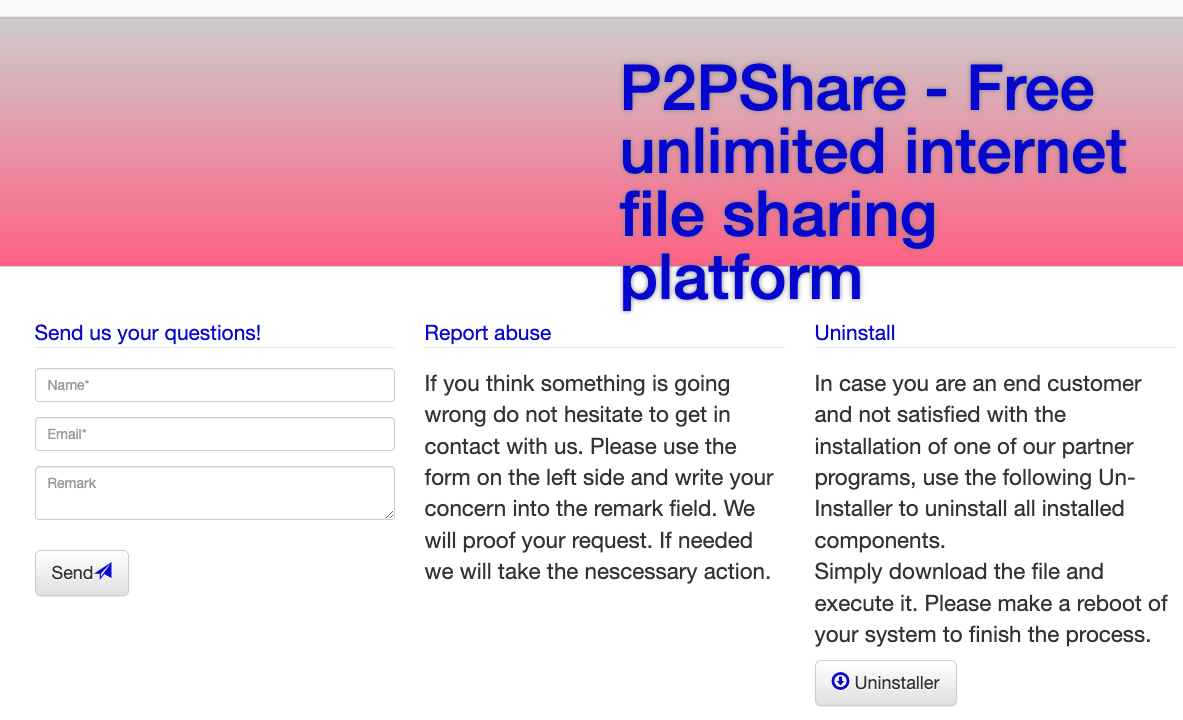
p2pshare.net, which bundled 911 proxy with an application that promised access to free unlimited internet file-sharing.
Still more domains associated with ustraffic@qq.com suggest 911’s proxy has been disguised as security updates for video player plugins, including flashplayerupdate[.]xyz, mediaplayerupdate[.]xyz, and videoplayerupdate[.]xyz.
The earliest version of the 911 website available from the Wayback Machine is from 2016. A sister service called proxygate[.]net launched roughly a year prior to 911 as a “free” public test of the budding new residential proxy service. “Basically using clients to route for everyone,” was how Proxygate described itself in 2016.
For more than a year after its founding, the 911 website was written entirely in Simplified Chinese. The service has only ever accepted payment via virtual currencies such as Bitcoin and Monero, as well as Alipay and China UnionPay, both payment platforms based in China.
Initially, the terms and conditions of 911’s “End User License Agreement (EULA) named a company called Wugaa Enterprises LLC, which was registered in California in 2016. Records from the California Secretary of State office show that in November 2016, Wugaa Enterprises said it was in the Internet advertising business, and had named as its CEO as one Nicolae Aurelian Mazgarean of Brasov, Romania.
A search of European VAT numbers shows the same Brasov, RO address tied to an enterprise called PPC Leads SRL (in the context of affiliate-based marketing, “PPC” generally refers to the term “pay-per-click”).
911’s EULA would later change its company name and address in 2017, to International Media Ltd. in the British Virgin Islands. That is the same information currently displayed on the 911 website.
The EULA attached to 911 software downloaded from browsingguard[.]com (tied to the same ustraffic@qq email that registered 911) references a company called Gold Click Limited. According to the UK Companies House, Gold Click Limited was registered in 2016 to a 34-year-old Yunhe Wang from Beijing City. Many of the WHOIS records for the above mentioned domains also include the name Yunhe Wang, or some variation thereof.
In a response to questions from KrebsOnSecurity, 911 said the researchers were wrong, and that 911 has nothing to do with any of the other domains mentioned above.
“We have 911 SDK link and how it works described clearly in the “Terms of use” of affiliated partners products, and we have details of how the community powered network works on our webpages,” read an email response.
“Besides that, for protecting the end users, we banned many domains’ access and blocked the vulnerable ports, e.g. spamming emails, and torrent is not possible from the 911 network,” the reply continued. “Same as scanning and many others…Accessing to the Lan network and router is also blocked. We are monitoring 911 user’s account closely, once any abnormal behavior detected, we suspend the user’s account right away.”
911 has remained one of the most popular services among denizens of the cybercrime underground for years, becoming almost shorthand for connecting to that “last mile” of cybercrime. Namely, the ability to route one’s malicious traffic through a computer that is geographically close to the consumer whose credit card they’re about to charge at some website, or whose bank account they’re about to empty.
Given the frequency with which 911 has been praised by cybercrooks on the top forums, it was odd to find the proprietors of 911 do not appear to have created any official support account for the service on any of several dozen forums reviewed by this author going back a decade. However there are two cybercriminal identities on the forums that have responded to individual 911 help requests, and who promoted the sale of 911 accounts via their handles.
Both of these identities were active on the crime forum fl.l33t[.]su between 2016 and 2019. The user “Transfer” advertised and sold access to 911 from 2016 to 2018, amid many sales threads where they advertised expensive electronics and other consumer goods that were bought online with stolen credit cards.
In a 2017 discussion on fl.l33t[.]su, the user who picked the handle “527865713” could be seen answering private messages in response to help inquiries seeking someone at 911. That identity is tied to an individual who for years advertised the ability to receive and relay large wire transfers from China.
One ad from this user in 2016 offered a “China wire service” focusing on Western Union payments, where “all transfers are accepted in China.” The service charged 20 percent of all “scam wires,” unauthorized wire transfers resulting from bank account takeovers or scams like CEO impersonation schemes.
In August 2021, 911’s biggest competitor — a 15-year-old proxy network built on malware-compromised PCs called VIP72 — abruptly closed up shop. Almost overnight, an overwhelming number of former VIP72 customers began shifting their proxy activities to 911.

The login page for VIP72, until recently 911’s largest competitor.
That’s according to Riley Kilmer, co-founder of Spur.us — a security company that monitors anonymity services. Kilmer said 911 also gained an influx of new customers after the Jan. 2022 closure of LuxSocks, another malware-based proxy network.
“911’s user base skyrocketed after VIP72 and then LuxSocks went away,” Kilmer said. “And it’s not hard to see why. 911 and VIP72 are both Windows-based apps that operate in a similar way, where you buy private access to IPs.”
Kilmer said 911 is interesting because it appears to be based in China, while nearly all of the other major proxy networks are Russian-backed or Russian-based.
“They have two basic methods to get new IPs,” Kilmer said. “The free VPN apps, and the other is trojanized torrents. They’ll re-upload Photoshop and stuff like that so that it’s backdoored with the 911 proxy. They claim the proxy is bundled with legitimate software and that users all agree to their Terms of Service, meanwhile they can hide behind the claim that it was some affiliate who installed the software, not them.”
Kilmer said at last count, 911 had nearly 200,000 proxy nodes for sale, spanning more than 200 countries: The largest geographic concentration is the United States, where more than 42,000 proxies are currently for rent by the service.
Beware of “free” or super low-cost VPN services. Proper VPN services are not cheap to operate, so the revenue for the service has to come from somewhere. And there are countless “free” VPN services that are anything but, as we’ve seen with 911.
In general, the rule of thumb for transacting online is that if you’re not the paying customer, then you and/or your devices are probably the product that’s being sold to others. Many free VPN services will enlist users as VPN nodes for others to use, and some even offset costs by collecting and reselling data from their users.
All VPN providers claim to prioritize the privacy of their users, but many then go on to collect and store all manner of personal and financial data from those customers. Others are fairly opaque about their data collection and retention policies.
I’ve largely avoided wading into the fray about which VPN services are best, but there are so many shady and just plain bad ones out there that I’d be remiss if I didn’t mention one VPN provider whose business practices and transparency of operation consistently distinguish them from the rest. If maintaining your privacy and anonymity are primary concerns for you as a VPN user, check out Mullvad.net.
Let me make clear that KrebsOnSecurity does not have any financial or business ties to this company (for the avoidance of doubt, this post doesn’t even link to them). I mention it only because I’ve long been impressed with their candor and openness, and because Mullvad goes out of its way to discourage customers from sharing personal or financial data.
To that end, Mullvad will even accept mailed payments of cash to fund accounts, quite a rarity these days. More importantly, the service doesn’t ask users to share phone numbers, email addresses or any other personal information. Nor does it require customers to create passwords: Each subscription can be activated just by entering a Mullvad account number (woe to those who lose their account number).
I wish more companies would observe this remarkably economical security practice, which boils down to the mantra, “You don’t have to protect what you don’t collect.”
Update, July 24, 11:15 a.m. ET: 911’s homepage now includes a banner saying the service has halted new registrations and payments. “We are reviewing our network and adding a series of security measures to prevent misuse of our services,” the message reads. “Proxy balance top-up and new user registration are closed. We are reviewing every existing user, to ensure their usage is legit and [in] compliance with our Terms of Service.”
Update, July 30, 10:07 a.m. ET: 911 announced on July 28 that it is permanently closing down, following a series of data breaches this month that 911 says resulted in the deletion of customer data.



Microsoft today released updates to fix at least 86 security vulnerabilities in its Windows operating systems and other software, including a weakness in all supported versions of Windows that Microsoft warns is actively being exploited. The software giant also has made a controversial decision to put the brakes on a plan to block macros in Office documents downloaded from the Internet.

In February, security experts hailed Microsoft’s decision to block VBA macros in all documents downloaded from the Internet. The company said it would roll out the changes in stages between April and June 2022.
Macros have long been a trusted way for cybercrooks to trick people into running malicious code. Microsoft Office by default warns users that enabling macros in untrusted documents is a security risk, but those warnings can be easily disabled with the click of button. Under Microsoft’s plan, the new warnings provided no such way to enable the macros.
As Ars Technica veteran reporter Dan Goodin put it, “security professionals—some who have spent the past two decades watching clients and employees get infected with ransomware, wipers, and espionage with frustrating regularity—cheered the change.”
But last week, Microsoft abruptly changed course. As first reported by BleepingComputer, Redmond said it would roll back the changes based on feedback from users.
“While Microsoft has not shared the negative feedback that led to the rollback of this change, users have reported that they are unable to find the Unblock button to remove the Mark-of-the-Web from downloaded files, making it impossible to enable macros,” Bleeping’s Sergiu Gatlan wrote.
Microsoft later said the decision to roll back turning off macros by default was temporary, although it has not indicated when this important change might be made for good.
The zero-day Windows vulnerability already seeing active attacks is CVE-2022-22047, which is an elevation of privilege vulnerability in all supported versions of Windows. Trend Micro’s Zero Day Initiative notes that while this bug is listed as being under active attack, there’s no information from Microsoft on where or how widely it is being exploited.
“The vulnerability allows an attacker to execute code as SYSTEM, provided they can execute other code on the target,” ZDI’s Dustin Childs wrote. “Bugs of this type are typically paired with a code execution bug, usually a specially crafted Office or Adobe document, to take over a system. These attacks often rely on macros, which is why so many were disheartened to hear Microsoft’s delay in blocking all Office macros by default.”
Kevin Breen, director of cyber threat research at Immersive Labs, said CVE-2022-22047 is the kind of vulnerability that is typically seen abused after a target has already been compromised.
“Crucially, it allows the attacker to escalate their permissions from that of a normal user to the same permissions as the SYSTEM,” he said. “With this level of access, the attackers are able to disable local services such as Endpoint Detection and Security tools. With SYSTEM access they can also deploy tools like Mimikatz which can be used to recover even more admin and domain level accounts, spreading the threat quickly.”
After a brief reprieve from patching serious security problems in the Windows Print Spooler service, we are back to business as usual. July’s patch batch contains fixes for four separate elevation of privilege vulnerabilities in Windows Print Spooler, identified as CVE-2022-22022, CVE-2022-22041, CVE-2022-30206, and CVE-2022-30226. Experts at security firm Tenable note that these four flaws provide attackers with the ability to delete files or gain SYSTEM level privileges on a vulnerable system.
Roughly a third of the patches issued today involve weaknesses in Microsoft’s Azure Site Recovery offering. Other components seeing updates this month include Microsoft Defender for Endpoint; Microsoft Edge (Chromium-based); Office; Windows BitLocker; Windows Hyper-V; Skype for Business and Microsoft Lync; and Xbox.
Four of the flaws fixed this month address vulnerabilities Microsoft rates “critical,” meaning they could be used by malware or malcontents to assume remote control over unpatched Windows systems, usually without any help from users. CVE-2022-22029 and CVE-2022-22039 affect Network File System (NFS) servers, and CVE-2022-22038 affects the Remote Procedure Call (RPC) runtime.
“Although all three of these will be relatively tricky for attackers to exploit due to the amount of sustained data that needs to be transmitted, administrators should patch sooner rather than later,” said Greg Wiseman, product manager at Rapid7. “CVE-2022-30221 supposedly affects the Windows Graphics Component, though Microsoft’s FAQ indicates that exploitation requires users to access a malicious RDP server.”
Separately, Adobe today issued patches to address at least 27 vulnerabilities across multiple products, including Acrobat and Reader, Photoshop, RoboHelp, and Adobe Character Animator.
For a closer look at the patches released by Microsoft today and indexed by severity and other metrics, check out the always-useful Patch Tuesday roundup from the SANS Internet Storm Center. And it’s not a bad idea to hold off updating for a few days until Microsoft works out any kinks in the updates: AskWoody.com usually has the lowdown on any patches that may be causing problems for Windows users.
As always, please consider backing up your system or at least your important documents and data before applying system updates. And if you run into any problems with these updates, please drop a note about it here in the comments.

In the spirit of #PrideMonth, McAfee hosted month-long celebrations across the world. One of these was a live event hosted by the McAfee Pride Community with a guest speaker from the Resource Center that focused on the history of Pride, support, allyship, and belonging.
We took a moment to ask our event guest speaker, Leslie McMurray, about the work that Resource Center does, the importance of pride, and what companies can do to create inclusive work environments.
“We like to say, if we had an “elevator pitch”, we would need a really tall building! Resource Center has been around for 39 years and is one of the largest LGBTQIA+ community centers in the United States, it is a primary HIV/AIDS service organization in Texas.
Some of the work that we do includes operating a food pantry and hot meal program that serves low-income people living with HIV. We have a case management department that helps locate resources that we don’t directly provide, like housing. And we have a primary care clinic that is gender-affirming and a ten-chair dental clinic that also serves those living with HIV.
We also have a youth program called Youth First that serves youth from middle-to-high school. We have a behavioral health program and a clinic that does free testing for HIV and STDs along with a mobile health unit that does free testing in outlying areas. Finally, our advocacy department has three full-time employees!
“Sometimes we get asked “What’s ‘Pride’ about? Why do you need a parade?”
It’s important to understand that LGBTQIA+ people are still working to achieve equal rights – the same as everyone else.
The tipping point of the fight for equal rights in the US dates back to 1969 when the Stonewall Uprising took place in Manhattan. The first Pride march was held a year later to honor the anniversary of the Stonewall Uprising and continues to take place during the month of June each year. And while we appreciate the attention during the month, the continued fight for equal rights for the LGBTQIA+ community is yearly, and we need continuous support and allyship of people and businesses year-round.
So it’s really important for people to learn about diverse populations, understand what their challenges are, and educate yourself on these issues – from that spring’s allies.”
“One of the simplest things for companies to do is to include ‘Sexual Orientation, Gender Identity and Gender expression’ in your Equal Employment Opportunity statement. Other things companies can do is to look at putting a policy in place for transgender employees who are transitioning and consider including transgender healthcare in your company benefits package.
Make sure to help foster understanding by getting employees to do training with organizations like Resource Center. And empower upper management to lead the way ensuring all employees can bring their whole selves to work. Finally, when the opportunity arises look at working with and bringing in non-profit organizations into your company to continue spreading awareness and support for the LGBTQIA+ community.
And while June wraps up Pride month, year-round we work towards a workplace and community where all can belong – a workplace where our unique differences are celebrated and where we all stand together for equality. #McAfeePride
Learn more about the incredible work that Resource Center does here
Interested in building your career at a company where you can belong? Search our openings!
The post #McAfeePride2022 appeared first on McAfee Blog.

It’s Social Media Day! How are you celebrating? Reposting your very first profile picture from a decade ago? Sharing your most-loved status update or the photo you’re most proud of? This year, consider commemorating the day by learning more about how to keep your information safe. Enjoy your favorite platform, but be on the lookout for scams, such as social engineering.
Social engineering is a cybercrime common to social media sites. It is a tactic where a cybercriminal lurks on people’s social media pages, gleaning personal information that they then use to impersonate them elsewhere.
With more than half of the global population on social media, you may think that a cybercriminal will never single you out from such a huge pool; however, it is possible.1 Luckily, you only have to make a few, easy changes to your online habits to keep your valuable private information just that: private. Check out these tips to make smart decisions and be more confident about your and your family’s online security.
Think of the types of posts you share with your dozens – or even hundreds or thousands! – of followers: updates about your life, where you live, work, or favorite travel destinations, your hobbies, pets, family members, etc. All of these details, that only you and those closest to you should know, are a valuable commodity to cybercriminals. Plus, now that social media shopping is growing in popularity, the credit card information linked to accounts is sweetening the deal for cybercriminals.
Here are a few social engineering scams that are common to social media.
People commonly create passwords based on things, places, and people that are important. Have you ever published a 20 questions-style get-to-know-me post? Those contain a lot of valuable personally identifiable information (PII). With just a few of those details about your personal life, cybercriminals can make educated guesses at your passwords, a tactic called credential stuffing. If they’re able to crack the code to one of your accounts, they’ll then input that password and login variations in several other sites, especially online banking portals, to see if they can gain entry to those too.
You’ve won! Send us your banking information and address, and you’ll receive a package in the mail or a direct deposit to your bank account!
But did you enter a drawing for a prize? Very rarely does anyone win something just by being a follower of a certain page. If you receive a message similar to the above, it’s likely a phisher trying to draw more PII and sensitive banking information out of you. Or, the message may have links within it that redirect to an untrustworthy site. If you regularly enter social media contests, keep a list and only respond to legitimate ones. Also, never give your banking information out over social media, private messages, or email.
There are plenty of valid fundraisers and petitions circulating around social media; however, there are just as many social engineering scams that dupe social media users because they inspire a strong emotion in them. For example, there have been several scams around Ukrainian donation sites. Cybercriminals often use fear, anger, or sadness to inspire people to open their wallets and share confidential banking information.
Luckily, all it takes is a few smart habits to stop social engineers in their tracks. Consider the following tips and make these small changes to your social media usage:
At this point, you’ve probably had several of your social media accounts active for over a decade. That means it’s time to do some cleaning out of your friends and followers lists. It’s best to only accept requests from people you personally know and would actually like to keep in the loop about your life. A friend and follower request from strangers could be cyber criminals in disguise. Also, consider setting your account to private so that your posts are invisible to strangers.
Social engineering hacks often bank on people acting rashly and quickly because of strong emotion, either excitement, fear, sadness, or anger. If you see a post on your newsfeed or receive a direct message that gives you a tight window to respond and asks for PII, slow down and think before acting. Double-check the destination of every link in the message by hovering over it with your cursor and checking the link preview at the bottom of your browser screen. Be careful, because some link previews include slight misspellings of legitimate websites. As a great rule of thumb, be automatically skeptical of direct messages from people you do not personally know. And if a DM from a friend seems out of the ordinary, shoot them a text to confirm they actually sent it. It could be that their social media account was hacked and a criminal is spamming their followers.
A password manager will go a long way toward ensuring you have unique, strong passwords and passphrases for every account. Not reusing passwords makes credential stuffing impossible. McAfee True Key stores all your logins and passwords and guards them with one of the strongest encryption algorithms available. All you need to do is remember your master password. It’s a great practice to also enable multifactor authentication whenever a website offers it. This makes it incredibly difficult for a cybercriminal to break into your online accounts with their educated guesses at your password.
Now that you know what to look for and the best tricks to be safe, you can feel more confident that you’re doing everything you can to protect your online accounts and private information. McAfee Protection Score can also help you take control of your online safety. This service allows you to monitor your current online safety and encourages you to take specific steps to improve it. Now you can enjoy digitally keeping in touch with your friends with peace of mind!
1Smart Insights, “Global social media statistics research summary 2022”
The post It’s Social Media Day! Here’s How to Protect Yourself From Social Engineering Online appeared first on McAfee Blog.
War in Europe, a reminder for shared service centers and shoring operations to re-examine IT security posture
The post Do back offices mean backdoors? appeared first on WeLiveSecurity





The growing number of internet crimes targeting senior adults is mind-blowing.
In 2021, more than 92,000 people over the age of 60 reported losses of $1.7 billion, according to IC3, the FBI’s Internet Crime division. That number reflects a 74 percent increase in losses from 2020.
These numbers tell us a few things. They tell us that scamming the elderly is a multi-billion-dollar business for cybercriminals. It also tells us that regardless of how shoddy or obvious online scams may appear to anyone outside the senior community, they are working.
However, information is power. Senior adults can protect their hard-earned retirement funds and government benefits by staying informed, adopting new behaviors, and putting tools in place designed to stop scammers in their tracks. And, when possible, family, friends, and caregivers can help.
The FBI said confidence fraud and romance scams netted over $281 million in losses.
The top four types of scams targeting seniors: Romance scams (confidence scams), fake online shopping, false utility representatives, and government agent imposters. Here’s how to make a few shifts to mindset and your daily routine and steer clear of digital deception.
Just as the seasons change in our lives, so too must our behaviors when connecting to people and information via our devices. Cybercriminals target older people because they assume they aren’t as informed about schemes or technically savvy as younger people. Senior adults and their loved ones can work daily to change that narrative. With the right mindset, information, and tools, seniors can connect online with confidence and enjoy their golden years without worrying about digital deception.
The post Seniors: How to Keep Your Retirement Safe from Online Scams appeared first on McAfee Blog.
Congratulations! You reached 10,000 steps today!
It’s a great feeling when a wearable fitness device vibrates to let you know when you hit the day’s fitness goal. The digital fireworks display that lights up your watch’s screen is a signal that you should keep on moving to challenge yourself more … or spend the rest of the day on the couch guilt-free.
While fitness wearable devices, trackers, and apps are excellent motivators for you, cybercriminals love them for their vulnerabilities and privacy loopholes. This doesn’t mean you have to chuck your expensive watch in the bin or delete your fitness apps from your smartphone. Awareness and smart habits go a long way in deterring cybercriminals. Keep reading to learn more about wearable technology vulnerabilities and how you can sidestep each.
Many fitness tracker apps and wearables are equipped with GPS. At the end of a run or long walk, you can view your exact route, sometimes with detailed maps that show street and town names. This tracking feature was potentially dangerous back in 2018 when a fitness app released a heat map of all its users’ running routes for the year, which clearly outlined secret military bases.1
Even if you’re stationed in a suburb and not hostile territory, you may consider the risks of sharing your location data. A determined criminal who has time to spare can guess your address and see the times of days when you’re commonly out at the gym or on a run.
When you purchase a wearable fitness device, you often have to pair it with an accompanying smartphone app to see your daily stats and tailor your fitness goals. Think about all the personally identifiable information (PII) that app now houses: your full name, password, address, height, weight, location, medical concerns, daily activity patterns, etc. In the hands of a cybercriminal, this information can bring a nefarious actor one step closer to impersonating you. Plus, if your health data makes it onto the dark web or is sold to health companies, it may result in serious privacy concerns.
Luckily, there are ways to get peace of mind about the security of your identity. Identity protection services, such as McAfee Identity Monitoring Service, provide expert identity theft support and up to $1 million in identity theft coverage.
Wearable devices complement any athleisure outfit and are a fun way to inspire athletic competition between a group of friends. Here are a few ways you can patch some of their security shortcomings:
When you first purchase any new device, fitness trackers included, your first step should always be to reset the factory password. Cybercriminals know that many people often skip this step, making it easy for them to walk right into new accounts. If you have a hard time remembering your passwords, consider entrusting them to a password manager to remember them for you. McAfee True Key makes it so that you only have to remember one master password to unlock the rest, and it’s protected by one of the strongest encryption algorithms available.
This is a tip you should consider for all your social media accounts. When you post about your life online, you actually divulge a lot of personal details that are helpful to cybercriminals. In the case of fitness trackers and apps, sharing the times of day when you go to the gym, are at the local track, or are on a bike path may give a criminal an idea of windows during the day when your home is empty. It’s unsettling to think that strangers can track your whereabouts, so it’s best to keep those details exclusive to people you personally know and trust.
In the case of fitness trackers and apps, a savvy cybercriminal may be able take an educated guess at your address, with which they can do a myriad of nefarious activities. Some running and fitness apps may be able to still create maps of your running routes but erase street names and other landmarks to make it more private. But when in doubt, turn off geolocation.
Fitness trackers are a fun way to stir up some friendly competition, keep connected with your fit friends, and motivate yourself to exercise and maintain healthy habits. While you’re shopping for a new device or when evaluating your current tracker, keep these tips in mind to enjoy this technology to its fullest.
The post Why You Should Care About Fitness Tracker Security appeared first on McAfee Blog.

There were multiple times during my digital parenting journey when I would have loved to put my head in the sand. Pretend that life was easy and that my kids weren’t going to grow up and want devices and to join social media. But I didn’t. I couldn’t. With four kids who had technology running through their veins, I had no choice but to embrace it.
While many kids will first experience the internet from a family laptop or via their parent’s phone at a coffee shop (we’ve all done it), it’s when they get these devices into their hot little hands unsupervised a few years down the track that the real show starts. And that’s usually when they get access to a phone. Research from our eSafety Office shows that just under half of Aussie kids between 6 and 13 use a smartphone with about 1/3 owning their own device.
And while we can all wax lyrical about the good old days when we used payphones and how great it would be if our kids didn’t have smartphones, we need to keep it real. Technology is not going anywhere so the best thing we can to accept it’s here, educates our kids about how to use it safely and introduce boundaries and rules to ensure they are as safe as possible.
So, without further ado, let me introduce you to the concept of a family technology contract – a great way to manage your kids and their tech use.
I like to think of a tech agreement as a clear outline of your expectations of your kids’ digital behavior – any behavior that occurs while using a device should be included in the agreement and yes, include TV here too! Now, before we progress, I have to share one key tip – don’t even think of putting together an agreement like this when tensions are high, or a heated argument is still in place – it will never work. Only talk about this or start working on it when you are in a calm and serene headspace.
The most important thing is to have an agreement that is suitable for your kids’ ages and maturity and one that works for your family’s schedule. There’s no point making your 5-year-old sign an agreement that limits their time on Instagram when they’re probably quite happy visiting only the online sites that you have ‘bookmarked’ for them. And if your kids have a super busy schedule then you might want to include a rule that means there is no ‘leisure screen time’ (eg TV/movie viewing) till all homework is complete.
While it’s entirely based on your kids’ interests and tech usage, I think 3 is a good age to start with a basic agreement. That’s when they start understanding rules. And how old is too old for a tech contract, I hear you ask? Well, I acknowledge that introducing new rules and boundaries when your kids are well into their teens may be difficult however if things feel out of control and you are concerned about their mental health and less than ideal digital habits then it may also be exactly what you all need!
Keeping an agreement age-appropriate and relevant is essential. You may also want to keep it simple and focus on a few key things, such as:
But it can include so much more. Here are some items you may choose to include in your own personalized version. Think of this list as a shopping list. Simply, pick & choose what works for the ages of your kids and your family’s structure.
Online Behaviour
I understand that access to my devices is a privilege and breaking this agreement will lead to the following consequences: (list what you feel is appropriate)
I would have all parties sign and date the agreement: both parents and kids. You may choose to keep a copy on the fridge? Again, whatever works for your situation.
So, if you are feeling like this digital parenting thing is getting the better of you, please consider introducing an agreement. For decades, parenting experts have written about the virtues of establishing clear boundaries for our kids and in my opinion, a tailored family tech agreement absolutely does that!
Good luck!!
Alex x
The post Why You Need to Get a Family Technology Agreement Happening appeared first on McAfee Blog.

As millions of people around the world practice social distancing and work their office jobs from home, video conferencing has quickly become the new norm. Whether you’re attending regular work meetings, partaking in a virtual happy hour with friends, or catching up with extended family across the globe, video conferencing is a convenient alternative to many of the activities we can no longer do in real life. But as the rapid adoption of video conferencing tools and apps occurs, is security falling by the wayside?
One security vulnerability that has recently made headlines is the ability for uninvited attendees to bombard users’ virtual meetings. How? According to Forbes, many users have posted their meeting invite links on social media sites like Twitter. An attacker can simply click on one of these links and interrupt an important conference call or meeting with inappropriate content.
Online conferencing tools allow users to hold virtual meetings and share files via chat. But according to Security Boulevard, communicating confidential business information quickly and privately can be challenging with these tools. For example, users are not always immediately available, even when working from home. In fact, many parents are simultaneously doubling as working parents and teachers with the recent closure of schools and childcare providers. If a user needs to share private information with a coworker but they are unable to connect by video or phone, they might revert to using a messaging platform that lacks end-to-end encryption, a feature that prevents third-party recipients from seeing private messages. This could lead to leaks or unintended sharing of confidential data, whether personal or corporate. What’s more, the lack of using a secure messaging platform could present a hacker with an opportunity to breach a victim’s data or device. Depending on the severity of this type of breach, a victim could be at risk of identity theft.
With the recent surge of new video conferencing users, privacy policies have been placed under a microscope. According to WIRED, some online conferencing tools have had to update their policies to reflect the collection of user information and meeting content used for advertising or other marketing efforts. Another privacy concern was brought to light by a video conferencing tool’s attention-tracking feature. This alerts the virtual meeting host when an attendee hasn’t had the meeting window in their device foreground for 30 seconds, resulting in users feeling that their privacy has been compromised.
As users become accustomed to working from home, video conferencing tools will continue to become a necessary avenue for virtual communication. But how can users do so while putting their online security first? Follow these tips to help ensure that your virtual meetings are safeguarded:
There are plenty of video conferencing tools available online. Before downloading the first one you see, do your research and check for possible security vulnerabilities around the tools. Does the video conferencing tool you’re considering use end-to-end encryption? This ensures that only meeting participants have the ability to decrypt secure meeting content. Additionally, be sure to read the privacy policies listed by the video conferencing programs to find the one that is the most secure and fits your needs.
To ensure that only invited attendees can access your meeting, make sure they are password protected. For maximum safety, activate passwords for new meetings, instant meetings, personal meetings, and people joining by phone.
To keep users (either welcome or unwelcome) from taking control of your screen while you’re video conferencing, select the option to block everyone except the host (you) from screen sharing.
By turning on automatic updates, you are guaranteed to have all the latest security patches and enhancements for your video conferencing tool as soon as they become available.
The post How Secure Is Video Conferencing? appeared first on McAfee Blog.

Whether you think you might have a virus on your computer or devices, or just want to keep them running smoothly, it’s easy to do a virus scan. How to check for viruses depends on the software and device you have, so we’ll go through everything you need to know to run a scan effectively and keep your computers, phones and tablets in tip-top shape.
First, let’s cover a few of the telltale signs your device might have a virus. Is your computer or device acting sluggish or having a hard time booting up? Have you noticed missing files or a lack of storage space? Have you noticed emails or messages sent from your account that you did not write? Perhaps you’ve noticed changes to your browser homepage or settings? Or maybe, you’re seeing unexpected pop-up windows, or experiencing crashes and other program errors. These are all examples of signs that you may have a virus, but don’t get too worried yet, because many of these issues can be resolved with a virus scan.
Each antivirus program works a little differently, but in general the software will look for known malware that meets a specific set of characteristics. It may also look for variants of these known threats that have a similar code base. Some antivirus software even checks for suspicious behavior. If the software comes across a dangerous program or piece of code, it removes it. In some cases, a dangerous program can be replaced with a clean one from the manufacturer.
The process of checking for viruses depends on the device type and its operating system. Check out these tips to help you scan your computers, phones and tablets.
If you use Windows 10, go into “Settings” and look for the “Updates & Security” tab. From there you can locate a “Scan Now” button.
Of course, many people have invested in more robust antivirus software that has a high accuracy rate and causes less drain on their system resources, such as McAfee Total Protection. To learn how to run a virus scan using your particular antivirus software, search the software’s help menu or look online for instructions.
Mac computers don’t have a built-in antivirus program, so you will have to download security software to do a virus scan. There are some free antivirus applications available online, but we recommend investing in trusted software that can protect you from a variety of threats. Downloading free software and free online virus scans can be risky, since cybercriminals know that this is a good way to spread malware.
Whichever program you choose, follow their step-by-step instructions on how to perform a virus scan, either by searching under “help” or looking it up on their website.
Yes, you can get a virus on your phone or tablet, although they are less common than on computers. However, the wider category of mobile malware is on the rise and your device can get infected if you download a risky app, click on an attachment in a text message, visit a dangerous webpage, or connect to another device that has malware on it.
Fortunately, you can protect your devices with mobile security software. It doesn’t usually come installed, so you will have to download an application and follow the instructions.
Because the Android platform is an open operating system, there are a number of antivirus products for Android devices, that allows you to do a virus scan.
Apple devices are a little different because they have a closed operating system that doesn’t allow third parties to see their code. Although Apple has taken other security precautions to reduce malware risks, such as only allowing the installation of apps from Apple’s official app store, these measures aren’t the same as an antivirus program.
For more robust protection on your Apple devices, you can install mobile security software to protect the private data you have stored on your phone or tablet, such as contacts, photos and messages.
If safeguarding all your computers and devices individually sounds overwhelming, you can opt for a comprehensive security product that protects computers, smartphones and tablets from a central control center, making virus prevention a breeze.
New online threats emerge every day, putting our personal information, money and devices at risk. In the first quarter of 2019 alone McAfee detected 504 new threats per minute, as cybercriminals employed new tactics. That’s why it is essential to stay ahead of these threats by using security software that is constantly monitoring and checking for new known threats, while safeguarding all of your sensitive information. Virus scans are an essential part of this process when it comes to identifying and removing dangerous code.
Most antivirus products are regularly scanning your computer or device in the background, so you will only need to start a manual scan if you notice something suspicious, like crashes or excessive pop-ups. You can also program regular scans on your schedule.
Of course, the best protection is to avoid getting infected in the first place. Here are a few smart tips to sidestep viruses and other malware:
The post How To Do A Virus Scan appeared first on McAfee Blog.

Molding and shaping our kids while we can is every parent’s dream. When kids are young – and sweet! – they are far more inclined to take on board our advice and lovingly imposed rules. Oh, how I miss those days!! And in a nutshell – that’s what a good set of parental controls can do for you and your kids. In my opinion, parental controls can absolutely help you create good habits but it’s essential that they are accompanied by an invested parent who’s keen to help their kids navigate the online world.
With Aussie kids spending at least 5 hours online a day, it’s no secret that they can be exposed to a broad range of people, websites and themes – some potentially quite disturbing. And with most kids sporting an internet-connected phone plus a laptop, there’s no limit to what they can access – and usually when you aren’t around.
I like to think of parental controls as another way of helping establish healthy habits and good decision-making strategies with your kids. For example, if you have told your kids there is no screen time before bed, then you are able to use Parental Controls to make that a reality. And if you have agreed that they are able to use only certain apps or social media platforms then Parental Controls can also make this happen by blocking access if they deviate. I believe that over time, these routines, and boundaries simply become part of your child’s day-to-day life and become good habits.
McAfee’s Parental Controls, called Safe Family, can also let you view your kids’ activity online and let you know where your kids are at all times. How good??
While it’s commonly believed that it takes just 21 days to form a habit, courtesy of Dr Maxwell Maltz in the 1960’s, more up-to-date research shows that it could take considerably longer. In fact, research conducted in 2010 by Health Psychology Researcher Philippa Lally at The University College in London shows that it takes around 2 months or 66 days to be precise to make a new habit stick!
And while I love the idea that we could help our kids adopt new positive habits in just 2 months, I think we need to keep it real. Fear of missing out (FOMO) coupled with the lure of their shiny devices might mean that it takes a little more than 66 days to make a change, particularly if you are trying to modify their current usage as opposed to starting from scratch.
There is no-one that better understands just how time poor parents can be. Having spent the last 20 plus years rearing 4 boys and working, I feel like I’ve earnt the time poor t-shirt! So, understandably, many parents feel like they just don’t have the ‘band with’ to take on much more so digital parenting is often put in the too hard basket. And I totally get it!
But using parental controls without some knowledge of your kids’ digital world, is a little like filling your car with petrol but not worrying about the oil. It will eventually be a problem!
So, I’m going to break it down for you. Digital parenting doesn’t have to be overwhelming, particularly if you break it down. So, in a quest to keep it simple, here are 4 things you can do to up your digital parenting game:
The day your child picks up a device is the day you start talking about cybersafety. If this is when they are 18 months of age, then that’s when you start. Always ensure the messages are age-appropriate and keep them simple. You could start with:
And when your kids get older, weave in more age-appropriate messages, such as:
Knitting cybersafety messages into your family dialogue needs to also become automatic. Talk about it just like you would sun safety or road safety. And why not share stories around the dinner table about your own online experiences or even relevant news stories to engage them in a dialogue.
I love the idea of a clear contract between parents and kids that details your expectations about their online behaviour and technology use. It’s a great way of developing a set of guidelines that will help them navigate the risks associated with being online. Now, this agreement should definitely be a family exercise so ensure your kids are invested in the process too. If you want a starting point, check out this one from The Modern Parent here.
Taking some time to understand how your child spends their time online is the best way of truly understanding the risks and challenges they face. So, join ALL the social media platforms your kids are on, play their games and download their messaging apps. You will develop a better understanding of how to manage privacy settings and the language/online culture that is a big part of your child’s life. And the best part – if they know you understand their world, I have no doubt that you will develop a little ‘tech cred’ which mean that they will be more likely to come to you with any issues or problems that may face online. Awesome!
There is some amazing technology available that makes this digital parenting thing a heck of a lot easier and that includes Parental Controls. McAfee’s Safe Family is a comprehensive parental controls solution that lets you monitor and block apps and websites, manage screen time, see where your kid’s devices are at all times, and more, giving you peace of mind in an ever-mobile world. The perfect partner to an invested parent!
Parental Controls can be an awesome way of helping your kids establish positive habits around their tech use, but they are even more impactful when combined with an invested parent who has got a good handle on the online world. So, by all means, invest in Parental Control software but also commit to ramping up your digital parenting game – it’s the best way to help set up your kids for a safe and positive experience online. And isn’t that every digital parent’s dream!
Take Care
Alex 
The post Can Parental Controls Can Help You Create Good Habits? appeared first on McAfee Blog.

While biometric tools like facial ID and fingerprints have become more common when it comes to securing our data and devices, strong passwords still play an essential part in safeguarding our digital lives.
This can be frustrating at times, since many of us have more accounts and passwords than we can possibly remember. This can lead us to dangerous password practices, such as choosing short and familiar passwords, and repeating them across numerous accounts. But password safety doesn’t have to be so hard. Here are some essential tips for creating bulletproof passwords.
Every year surveys find that the most popular passwords are as simple as “1234567” and just “password.” This is great news for the cybercrooks, but really bad news for the safety of our personal and financial information.
When it comes to creating strong passwords, length and complexity matter because it makes them harder to guess, and harder to crack if the cybercriminal is using an algorithm to quickly process combinations. The alarming truth is that passwords that are just 7 characters long take less than a third of a second to crack using these “brute force attack” algorithms.
Tricks:
Passwords that include bits of personal information, such as your name, address, or pet’s name, make them easier to guess. This is especially true when we share a lot of personal information online. But you can use personal preferences that aren’t well known to create strong passphrases.
Tricks:
If you reuse passwords and someone guesses a password for one account, they can potentially use it to get into others. This practice has gotten even riskier over the last several years, due to the high number of corporate data breaches. With just one hack, cybercriminals can get their hands on thousands of passwords, which they can then use to try to access multiple accounts.
Tricks:
If just the thought of creating and managing complex passwords has you overwhelmed, outsource the work to a password manager! These are software programs that can create random and complex passwords for each of your accounts, and store them securely. This means you don’t have to remember your passwords – you can simply rely on the password manager to enter them when needed.
Tricks:
Now that you’ve made sure that your passwords are bulletproof, make sure you have comprehensive security software that can protect you from a wide variety of threats.
Tricks:
The post 5 Tips For Creating Bulletproof Passwords appeared first on McAfee Blog.

Passwords: we entrust our most important data to these strings of letters, numbers, and special characters. So, we should make sure our passwords are words or phrases that we can easily remember, right? While this might be the most convenient option, there are more secure ways to digitally lock up your most sensitive personally identifiable information (PII). In celebration of World Password Day, we’re diving into how you can practice top-notch password security without compromising convenience.1
Over the years, the password has remained a good first line of defense against cyberattacks. However, most of us tend to choose passwords based on memorable things from our lives, like family names or our pets’ birthdays. As it turns out, these details are easy for hackers to find on social media sites like Facebook or LinkedIn. It’s also human nature to opt for convenience, and for many people that means setting easy-to-remember and easy-to-guess passwords. Plus, out of convenience, people often reuse passwords across multiple accounts and services. The downside is that if one account becomes compromised, all accounts become compromised.
As an alternative to single-word passwords, many security experts advocate for passphrases over passwords. Passphrases are longer strings of words and characters that are easier for you to remember and harder for nefarious software and cybercriminals to guess than random strings of upper and lowercase letters, numbers and symbols. But, according to a study, the average American internet user was projected to have 300 online accounts by 2022.2 Can you imagine memorizing 300 different passphrases? We can all agree that sounds pretty unrealistic, so users tend to look for other solutions.
If the answer is yes, you may want to reconsider, as there are several risks associated with this practice. Although it’s convenient to have your browser save your passwords, they tend to do a lousy job of safeguarding your passwords, credit card numbers and personal details, such as your name and address.
Let’s take Google Chrome, for example. Unlike most dedicated password managers, Chrome doesn’t use a primary password to encrypt all your credentials. (Note that some browsers do use one, and are therefore more secure, though you’ll still need to trust your browser provider.) This makes your Chrome-stored passwords relatively weak to “local” attacks. For example, if someone gets hold of—or guesses—your Windows password, they can then see all the logins stored in your browser’s password manager.
Another consideration to note is that the security of all your accounts is tied to your browser account’s security. Let’s say you use the sync option to make your credentials available on all your devices. This means that logins are stored in the cloud and, though encrypted, if someone manages to hack into your browser account, they will gain access to all your logins.
What can you do to help ensure your online profiles are kept safe without spending hours managing a complex list of passwords? Here are some easy ways to lock down your digital life without sacrificing convenience:
A password manager is a software application that stores your passwords and other sensitive information. You can install it on computers or mobile devices and store all passwords in an encrypted file (or database). The best option is to use a password manager like McAfee True Key to store and create strong, random passwords for each site you visit. You’ll have one primary password that grants access to the rest of them—ideally, a long and random passphrase that you can remember. Once everything is set up, it should be seamless. As you log in to new sites, the password manager will offer to save your credentials for later use.
One of the best ways to protect your accounts against unauthorized access is to turn on two-factor authentication for every site that offers it. Using two-factor authentication means a site will prompt you for a unique security code, in addition to your password, whenever you log in to an account for which you have enabled this feature.
Two-factor authentication adds an extra layer of security by requiring another form of identification after you enter your username and password. Some services send a temporary passcode over a text message. Others require the user to approve login attempts from new devices using an app. If someone steals your device or gains access to your account details, they’re out of luck unless they also have access to this second piece of information. Two-factor authentication is available on a wide range of websites and can help keep your accounts safe from would-be hackers, so you should always use it when available.
A VPN, or virtual private network, encrypts your data and masks your online behavior from snooping third parties. When you go to a website, your computer connects to the server where the site is hosted, and that website can see a certain amount of data about you and your computer. With a VPN, you connect to a private server first, which scrambles your data and makes it more difficult for digital eavesdroppers to track what you’re doing online.
VPNs can provide users with greater peace of mind when on the go. Say you’re traveling on a business trip and need to connect to the Wi-Fi network provided by your hotel. Shifty characters often lurk on unprotected, free networks (such as those provided by hotels, coffee shops, airports, etc.) to lift PII from people handling sensitive emails, making banking transactions, or shopping online. encrypts your online activity with bank-grade encryption to protect your data from prying eyes. With a premium paid plan, you can protect up to five devices at once and enjoy unlimited data protection.
With your growing number of accounts all requiring passwords—emails, social media profiles, online banking—it’s no wonder that people tend to reuse passwords across multiple sites. This may be convenient, but it creates significant security risks if a suspicious actor manages to obtain one of your passwords and attempts to use it elsewhere. That’s why having strong passwords matters.
Do yourself a favor and opt for a dedicated password manager that will auto-save and store your credentials for you, so you only have one password to remember. Who says security and simplicity can’t coexist?
The post This World Password Day, Here’s How a Password Manager Can Simplify Your Life appeared first on McAfee Blog.





So is your smart speaker really listening in on your conversations?
That’s the crux of a popular privacy topic. Namely, are we giving up some of our privacy in exchange for the convenience of a smart speaker that does our bidding with the sound of our voice? After all, you’re using it to do everything from search for music, order online, and control the lights and temperature in your home.
What is your smart speaker really hearing—and recording?
Let’s take a look at what’s going on inside of your smart speaker, how it processes your requests, and what companies do with the recordings and transcripts of your voice.
More or less, smart speakers are listening to all the time. Each smart speaker has its own “wake word” that it listens for, like Alexa, Siri, or Google. When the device hears that wake word or thinks it hears it, it begins recording and awaits your verbal commands. Unless you have the microphone or listening feature turned off, your device indeed actively listens for that wake word all the time.
Here’s where things get interesting, though. There’s a difference between “listening” and “recording.” The act of listening is passive. Your smart speaker is waiting to hear its name. That’s it. Once it does hear its name, it begins recording for a few seconds to record your command. From there, your spoken command goes into the company’s cloud for processing by way of an encrypted connection.
There are exceptions to when your command may go to the company’s cloud for processing, like Siri on iPhones, which according to Apple, “You don’t sign in with your Apple ID to use Siri, and the audio of your requests is processed entirely on your iPhone.” Also, Google Assistant may process some requests without going to the cloud, like “When a user triggers a smart home Action that has a local fulfillment path, Assistant sends the EXECUTE intent or QUERY intent to the Google Home or Google Nest device rather than the cloud fulfillment.”
In the cases where information does go to the cloud, processing entails a few things. First, it makes sure that the wake word was heard. If it’s determined that the wake word was indeed spoken (or something close enough to it—more on that in a minute), the speaker follows through on the request or command. Depending on your settings, that activity may get stored in your account history, whether as a voice recording, transcript, or both. If the wake word was not detected, processing ends at that point.
Enter the issue of mistaken wake words. While language models and processing technologies used by smart speakers are constantly evolving, there are occasions where a smart speaker acts as if a wake word was heard when it simply wasn’t said. Several studies on the topic have been published in recent years. In the case of research from Northeastern University, it was found that dialogue from popular television shows could be interpreted as wake words that trigger recording. For example, their findings cite:
“We then looked at other shows with a similarly high dialogue density (such as Gilmore Girls and The Office) and found that they also have a high number of activations, which suggests that the number of activations is at least in part related to the density of dialogue. However, we have also noticed that if we consider just the amount of dialogue (in a number of words), Narcos is the one that triggers the most activations, even if it has the lowest dialogue density.”
Of interest is not just the volume of dialogue, but the pronunciation of the dialogue:
“We investigated the actual dialogue that produced Narcos‘ activations and we have seen that it was mostly Spanish dialogue and poorly pronounced English dialogue. This suggests that, in general, words that are not pronounced clearly may lead to more unwanted activations.”
Research such as this suggests that smart speakers at the time had room for improvement when it comes to properly detect wake words, thus leading to parts of conversation being recorded without the owner intending it. If you own a smart speaker, I wouldn’t be too surprised to hear that you’ve had some issues like that from time to time yourself.
As mentioned above, the makers of smart speakers make constant improvements to their devices and services, which may include the review of commands from users to make sure they are interpreted correctly. There are typically two types of review—machine and human. As the names suggest, a machine review is a digital analysis and human reviews entail someone listening to and evaluating a recorded command or reading and evaluating a transcript of a written command.
However, several manufacturers let you exercise some control over that. In fact, you’ll find that they post a fair share of articles about this collection and review process, along with your choices for opting in or out as you wish:
The quickest way to ensure a more private experience with your smart speaker is to disable listening—or turn it off entirely. Depending on the device, you may be able to do this with the push of a button, a voice command, or some combination of the two. This will keep the device from listening for its wake word. Likewise, this makes your smart speaker unresponsive to voice commands until you enable them again. This approach works well if you decide there are certain stretches of the day where your smart speaker doesn’t need to be on call.
Yet let’s face it, the whole idea of a smart speaker is to have it on and ready to take your requests. For those stretches where you leave it on, there’s another step you can take to shore up your privacy.
In addition to making sure you’re opted out of the review process mentioned above, you can also delete your recordings associated with your voice commands.
Managing your voice history like this gives you yet one more way you can take control of your privacy. In many ways, it’s like deleting your search history from your browser. And when you consider just how much activity and how many queries your smart speaker may see over the course of days, weeks, and months, you can imagine just how much information that captures about you and your family. Some of it is undoubtedly personal. Deleting that history can help protect your privacy in the event that information ever gets breached or somehow ends up in the hands of a bad actor.
Lastly, above and beyond these privacy tips for your smart speakers, comprehensive online protection will help you look out for your privacy overall. In the case of ours, we provide a full range of privacy and device protection, along with identity theft protection that includes $1M identity theft coverage, identity monitoring, and identity restoration assistance from recovery pros—and antivirus too, of course. Together, they can make your time spent online far more secure.
You’re the smart one in this relationship
With privacy becoming an increasingly hot topic (rightfully so!), several companies have been taking steps to make the process of managing yours easier and a more prevalent part of their digital experience. As you can see, there are several ways you can take charge of how your smart speaker uses, and doesn’t use, your voice.
It used to be that many of these settings were tucked away deep in menus, rather than something companies would tout on web pages dedicated to privacy. So as far as smart speakers go, the information is out there, and I hope this article helps make the experience with yours more private and secure.
The post Smarter Homes & Gardens: Smart Speaker Privacy appeared first on McAfee Blog.

As an avid internet surfer, you’ve most likely heard of cookies. No, we’re not talking about the ones filled with chocolate chips. We’re talking about the ones that allow you to log in to your favorite websites. Cookies may impact your online security, so check out these tips to manage them and keep your online accounts safe.
Ever wonder how a website saves the items you placed in your shopping cart last week, even though you closed the tab before making the purchase? This is made possible by cookies. According to the Federal Trade Commission, a cookie is information saved by your web browser. When you visit a website, the site may place a cookie on your web browser so it can recognize your device in the future. If you return to that site later, it can read that cookie to remember you from your last visit, keeping track of your activities over time.1
Cookies come in either the first-party or third-party variety. There’s no difference between the two in how they function, but rather in where and how you encountered them. First-party cookies belong to sites you visited first-hand in your browser. Third-party cookies, or “tracking cookies,” generally come from third-party advertising websites.
Although cookies generally function the same, there are technically two different types of cookies. Magic cookies refer to packets of information that are sent and received without changes. Historically, this would be used to log in to a computer database system, such as an internal business network. This concept predates the modern cookie we use today.
HTTP cookies are a repurposed version of the magic cookie built for internet browsing and managing online experiences. HTTP cookies help web developers give you more personalized, convenient website experiences. They allow sites to remember you, your website logins, and shopping carts so you can pick back up where you left off from your last visit. However, cybercriminals can manipulate HTTP cookies to spy on your online activity and steal your personal information.
Cookie hijacking (also known as session hijacking) is typically initiated when a cybercriminal sends you a fake login page. If you click the fake link, the thief can steal the cookie and capture anything you type while on the fraudulent website. Like a phishing attack, cookie hijacking allows a cybercriminal to steal personal information like usernames, passwords, and other important data held within the cookie. If you enter your information while on the fake website, the criminal can then put that cookie in their browser and impersonate you online. They may even change your credentials, locking you out of your account.
Sometimes, criminals initiate cookie hijacking attacks without a fake link. If you’re browsing on an unsecured, public Wi-Fi connection, hackers can easily steal your data that’s traveling through the connection. This can happen even if the site is secure and your username and password are encrypted.
Because the data in cookies doesn’t change, cookies themselves aren’t harmful. They can’t infect computers with viruses or malware. But if your cookies are hijacked as part of a cyberattack, a criminal could gain access to your browsing history and use cookies as the key to enter your locked accounts. For example, a hacker may steal your identity or confidential company information, purchase items in your online shopping carts, or loot your bank account.
Preventing cookie hijacking attacks can allow you to browse the internet with greater peace of mind. Follow these tips to not only safeguard your personal information but to also enhance your browsing experience:
Make it a habit to clear your cookie cache regularly to prevent cookie overload, which could slow your search speeds. Also, almost every browser has the option to enable/disable cookies on your computer. So if you don’t want them at all, your browser’s support section can walk you through how to disable them.
Although it’s convenient to not have to re-type your credentials into a website you frequently visit, autofill features could make it easier for a criminal to extract your data with cookie hijacking. Plus, autofill is risky if your physical device falls into the wrong hands. To browse more securely without having to constantly reenter your passwords, use a password manager like McAfee True Key. True Key makes it so you only have to remember one master password, and it encrypts the rest in a vault protected by one of the most secure encryption algorithms available.
Strong, unique passwords for each of your accounts, updated regularly, offer ample protection against hackers. Multi-factor authentication (MFA) adds yet another layer of security by double-checking your identity beyond your username and password, usually with a texted or emailed code. When your accounts offer MFA, always opt in.
Criminals can hijack your cookies if you’re browsing on an unsecured, public Wi-Fi connection. To prevent a criminal from swiping your data, use a virtual private network (VPN), a service that protects your data and privacy online. A VPN creates an encrypted tunnel that makes you anonymous by masking your IP address while connecting to public Wi-Fi hotspots. This is a great way to shield your information from online spies while you’re banking, shopping, or handling any kind of sensitive information online.
McAfee LiveSafe is an antivirus solution that protects your computer and mobile devices from suspicious web cookies by:
is an antivirus solution that protects your computer and mobile devices from suspicious web cookies by:
The post What Are Browser Cookies and How Do I Manage Them? appeared first on McAfee Blog.

What’s worse than a surprise call from a law enforcement official telling you to pay a fine or be forced to serve time? Providing your personal information and paying that fine only to find out that it was all a scam. You didn’t miss jury duty; you didn’t commit a crime — you were just tricked into thinking that you did.
Sound unbelievable? It’s more likely than you’d think.
According to ZDNet1, the FBI released a warning about scammers impersonating government officials or law enforcement agencies to steal personal information and money from unsuspecting people.
After acquiring phone numbers and names from real users, scammers use fake credentials from well-known law enforcement agencies to contact victims. Under the guise of these officials, scammers claim that the user’s identity was used in a crime and ask them to provide their social security number and date of birth for verification. The fraudsters will also call or text about apparently missed jury duty, missed court dates, warrants out for arrest, or other local fines that require payment to be solved.
These criminals demand payment in multiple forms, but the most common are prepaid cards, wire transfers, and cash sent through mail or through cryptocurrency ATMs. If victims do not pay these fines or provide their personal information, the scammers in disguise will threaten them with potential prosecution or arrest.
The FBI states that no law enforcement agency will ever contact you asking for money, but if you’re still unsure whether you’re being scammed, here are a few more phishing tips that can help:
Unsolicited phone calls or texts are best avoided altogether or confirmed with a second source. Verify the caller’s identity with the organization they claim they represent. Ask for a name and position and make it clear you will be following up to verify their identity.
Do not reveal any personal or financial information over the phone, through text, or through a link provided in a text message.
Generic greetings that do not address you by name, especially when asking you to verify your identity or pay a fine, are a definite indicator that you may be being scammed.
Any strange grammar or spelling mistakes in a text message can be signs that this is someone impersonating an official agency, company, or higher-up to scam you.
Although scammers try to trick users over the phone, phishing scams can also happen over email. In addition to the tactics mentioned above, here are some extra tips on how to detect and avoid phishing emails:
Cybercriminals will often impersonate well-known brands or individuals by using fraudulent email addresses with just a few alterations of letters or characters. An example is an email address that appears as “bank0famerica.con.”
If you receive a message or email with a link, hover over the link without clicking on it. This will allow you to see a link preview. If the URL looks suspicious or doesn’t match up with the content in the email, do not interact with it and delete the entire message.
Be cautious of any attachment in an email. Scammers often use attachments as a sneaky way to deliver viruses and malware onto unsuspecting people’s devices.
Phishing scams can be deceitful, especially with the added pressure of a seemingly real (but definitely fake) government official or law enforcement agency accusing you of breaking the law. However, by following the tips outlined above, you’ll be able to spot these scams from a mile away and stay safer online!
The post What the FBI Wants You to Know About the Latest Phishing Scheme appeared first on McAfee Blog.




Outfitting your smart home could get a whole lot easier this year.
A new industry standard called Matter aims to remove a big barrier in smart home technology, one that makes different smart home devices compatible with any smart home platform—something that wasn’t possible until now.
For years, different smart home devices have run on several different competing platforms, such as Amazon Alexa, Apple HomeKit, Google Assistant, or Samsung SmartThings. And put plainly, those different platforms didn’t work with each other. And that was unfortunate. After all, the vision for the smart home was to run everything from lights, appliances, doorbell cameras, and all kinds of connected things in your home from a central set of controls, regardless of device manufacturer or platform.
But that hasn’t been the case, and this lack of compatibility created some headaches for homeowners. They’ve had to choose between one smart home platform over another and then only use smart devices built for that platform. For example, if you’re running a bunch of devices on Apple HomeKit and find a great deal on a new Samsung smart refrigerator with Alexa built-in, you’re pretty much out of luck if you want those devices to all work together as one in your smart home. The result is that consumers have had to check the fine print to see what’s compatible with what when shopping for smart devices. Again, a real headache.
Matter aims to take care of that. It’s hailed as a unifying technology that will make all those devices work together. Right now, the first wave of Matter-enabled devices is on track for a mid-year launch, which means we may finally see that vision of a smart home come true—a place where all your connected stuff works together with just the sound of your voice or a tap on your phone.
With that, let’s take a closer look at the new Matter protocol and what it offers, along with a look at security and privacy for smart home devices in general.
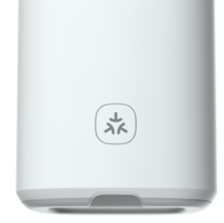
Without getting too technical about it, Matter is designed to create a more energy-efficient, secure, and reliable network for your smart home devices. Additionally, it’s designed to run independently of your internet connection, so if your internet goes out, you can still control your smart devices locally—from the app or device of your choice.
The tech industry looks like they’re very much on board. Matter is led by the Connectivity Standards Alliance, a body of more than 200 technology companies working together to create this new standard. And if you’re wondering Amazon, Apple, Google, and Samsung are among the many members of this alliance. If the launch goes as planned, you can expect to see Matter-enabled devices and the Matter logo on several new products by the middle of the year.
Additionally, several companies have announced that they will provide an upgrade path for existing products so that their existing customers don’t have to scrap their current smart home devices to take advantage of Matter.
In all, the idea is exciting. What remains to be seen is how security and privacy matters are handled, not only by the network but by the devices on it.
As far as security goes, Matter uses a combination of encryption and blockchain technology to secure transmitted data and ensure that only the devices you trust can use the network. Considering that you may be heating your home, warming up your oven, or even locking your front door, security features like these only make sense.
Yet looking beyond Matter and thinking about connected homes more broadly, there are a few question marks when it comes to privacy.
Imagine for a moment what a highly connected home might look like—and all the data those connections will generate. That data will show what time of day your front door tends to unlock and lock when family members go to and from work, school, or what have you. It’ll also show when you tend to turn on your lights, cook your dinner, or turn on the house alarm for the night.
Over time, all this data can piece together a picture of your comings and goings during a typical week. Shy of a bad actor physically casing out your home over several days, data like this simply hasn’t existed until the age of the connected home. If that data goes unprotected or if the devices creating it don’t give you some control over it, the privacy risks will run high.
Moreover, data privacy policies come into play here as well. As consumers like us are very much aware these days, not every company treats your data the same way. Some companies have different policies around what data they may collect and then what they do with that data—like cloud sites for other smart devices, government agencies, insurance companies, law enforcement, data aggregators, data banks, social media sites, and others according to findings published by some industry groups. In a smart home that’s kitted out with devices from five, seven, or even more different manufacturers, that are multiple privacy policies in play—each of which may view and treat your private data in their own way. That’s potentially volumes of your data circulating out there, potentially in ways you aren’t aware of or that give you any control over its use.
Of course, the issue of data privacy is nothing new and certainly not specific to smart devices. Already, the dozens of different apps and services we use as we go about our day have their own data privacy policies as well. Devices in a smart home only add to that mix, which is worth considering in our already highly connected lives.
As I write this, Matter has yet to be released. Yet if you already have some smart devices in your home, you may be wondering how to make your connected home safer. Let’s take a look at a few of the things you can do to protect your smart devices and the home network they’re running on.
Many smart home devices use a smartphone as a sort of remote control, not to mention as a place for gathering, storing, and sharing data. So whether you’re an Android owner or iOS owner, protect your smartphone so you can protect the things it accesses and controls—and the data stored on it too.
Early on when the first sets of smart home devices rolled out, some found themselves open to attack because they come with a default username and password, which hackers often publish on the internet as part of massive listings. (Baby monitors are a classic example.) And it remains an issue today. When you purchase any IoT device, set a fresh password using a strong method of password creation. Likewise, create an entirely new username for additional protection as well.
Another device that needs good password protection is your internet router. Make sure you use a strong and unique password there as well to help prevent hackers from breaking into your home network. (A password manager as part of comprehensive online protection can help.) Also, consider changing the same of your home network so that it doesn’t personally identify you. (I’ve seen some fun alternatives to using your name or address, everything from movie lines like “May the Wi-Fi be with you” to old sitcom references like “Central Perk.”) Also check that your router is using an encryption method, like WPA2, which will keep your signal secure. If you haven’t done this sort of thing before, check the documentation that came with your router or with the internet provider if you rent or purchased it from them.
Online banks, shops, and other services commonly offer multi-factor authentication to help protect your accounts—with the typical combination of your username, password, and a security code sent to another device you own (often a mobile phone). If your IoT device supports multi-factor authentication, consider using it there too. It throws a big barrier in the way hackers simply try and force their way in with a password/username combination, which will make your device tougher to crack.
In addition to fixing the odd bug or adding the occasional new feature, app and device updates often address security gaps. Out-of-date apps and devices may have flaws that hackers can exploit, so regular updating is a must from a security standpoint. If you can set your smart home apps and devices to receive automatic updates, even better.
Smart homes show plenty of promise. Seeing a new and broadly adopted industry standard like Matter on the horizon may make them even more promising. Ideally, Matter will make it easier for people to bring more smart devices in their homes, and in a way that’s reliable and secure. Moreover, there are steps you can take now to help keep your smart home devices, and smart home in general, more secure as well.
Yet when it comes to thinking about a home full of smart devices, questions around privacy remain. Smart home devices offered by different manufacturers will have different privacy policies and thus use people’s data in different ways, which puts consumers like us in a position to understand the terms, conditions, and implications of each one. Yet with data privacy being such a hot topic for consumers, the industry, and regulators already, it remains to be seen what consumer-friendly standards are set for data collection in the years to come—both in and out of the smart home.
The post Smarter Homes & Gardens: Protecting the Smart Devices in Your Home appeared first on McAfee Blog.


android-1200


The White House recently reissued a warning to American businesses in response to the unprecedented economic sanctions the U.S. has imposed on Russia for the Ukraine invasion, stating, “There is now evolving intelligence that Russia may be exploring options for potential cyberattacks.”
Along with this statement, the White House published a fact sheet outlining the new and ongoing steps the government is taking to protect its infrastructure and technologies, along with steps that private businesses can take to protect themselves from attacks as well.
Of course, any successful attack on government operations and the operations of private businesses could potentially affect households as well—such as in the case of data breaches where data or information is stolen from a system, often the personal data and information of individuals.
Word of potential attacks understandably leaves people feeling uncertain and may further leave them wondering if there’s anything they can do to protect themselves. With regards to data breaches and the cases of identity theft that typically follow, there are several steps people can take to keep safer online.
Let’s break down what a data breach looks like, how it can affect you, and what you can do in advance of a breach to protect yourself.
We’ve certainly seen data breaches make the news over the years, which are often (but not always) associated with malicious hackers or hacker organizations. A quick list of some of the largest and most impactful breaches we’ve seen in recent years:
Healthcare facilities have seen their data breached, along with the operations of popular restaurants. Small businesses find themselves in the crosshairs as well, with one report stating that 43% of data leaks target small businesses. Those may come by way of an attack on where those businesses store their records, a disgruntled employee, or by way of a compromised point-of-sale terminal in their store, office, or location.
What differs with the White House warning is who may end up being behind these potential attacks—a nation-state rather than what are financially motivated hackers or hacking groups. (Some research indicates that nearly 90% of breaches are about the money.) However, the result is the same. Your personal information winds up loose in the world and possibly in the hands of a bad actor.
The fact is that plenty of our information is out there on the internet, simply because we go about so much of our day online, whether that involves shopping, banking, getting results from our doctors, or simply hopping online to play a game once in a while.
Naturally, that means the data in any given breach will vary from service to service and platform to platform involved. Certainly, a gaming service will certainly have different information about you than your insurance company. Yet broadly speaking, there’s a broad range of information about you stored in various places, which could include:
As to what gets exposed and when you might find out about it, that can vary greatly as well. One industry research report found that 60% of breaches were discovered in just days from the initial attack while others could take months or even longer detect. Needless to say, the timeline can get rather stretched before word reaches you, which is a good reason to change your passwords regularly should any of them get swept up in a breach. (An outdated password does a hacker no good—more on that in a bit.)
The answer is plenty. In all, personal information like that listed above has a dollar value to it. In a way, your data and information are a kind of currency because they’re tied to everything from your bank accounts, investments, insurance payments—even tax returns and personal identification like driver’s licenses.
With this information in hand, a crook can commit several types of identity crimes—ranging from fraud to theft. In the case of fraud, that could include running up a bill on one of your credits cards or draining one of your bank accounts. In the case of theft, that could see crooks impersonate you so they can open new accounts or services in your name. Beyond that, they may attempt to claim your tax refund or potentially get an ID issued in your name as well.
Another possibility is that a hacker will simply sell that information on the dark marketplace, perhaps in large clumps or as individual pieces of information that go for a few dollars each. However it gets sold, these dark-market practices allow other fraudsters and thieves to take advantage of your identity for financial or another gain.
The succinct answer is to sign up for an identity protection service. It can monitor dozens of types of personal information and then alert you if any of them are possibly being misused, so you can address any issues right away before they become a potentially much bigger problem.
Further, pairing identity protection with online protection software can protect you even more. With an all-up view of your overall online security—how well you’re protecting yourself and your identity online—it can guide you through steps that can shore up your protection and make you safer still.
When a business, service, or organization falls victim to a breach, it doesn’t always mean that you’re automatically a victim too. Your information may not have been caught up in it. However, it’s best to act as if it was. With that, we strongly suggest you take these immediate steps.
Given the possibility that your password may be in the hands of a bad actor, change it right away. Strong, unique passwords offer one of your best defenses against hackers. Update them regularly as well. As mentioned above, this can protect you in the event a breach occurs and you don’t find out about it until well after it’s happened. You can spare yourself the upkeep that involves a password manager that can keep on top of it all for you. If your account offers two-factor authentication as part of the login process, make use of it as it adds another layer of security that makes hacking tougher.
If you spot unusual or unfamiliar charges or transactions in your account, bank, or debit card statements, follow up immediately. That could indicate improper use. In general, banks, credit card companies, and many businesses have countermeasures to deal with fraud, along with customer support teams that can help you file a claim if needed.
As outlined above, identity protection like ours can monitor a broad set of your personal information and provide you guidance for making it more secure, in addition to getting help from a professional recovery specialist.
For an even closer look at identity theft, we have two articles that can help guide the way if you think you’re a victim, each featuring a series of straightforward steps you can take to set matters right:
No matter how uncertain news of possible cyberattacks may any of us feel, you can take steps to set some of that uncertainty aside. An identity protection service is a strong first move against possible identity theft, as is pairing it with online protection software that keeps you safer online overall. Likewise, knowing the signs of possible identity theft and what you can do to address it right away offer further assurance still—like having the services of a professional recovery specialist to help.
In all, there’s no need to leave yourself wondering at the news from the White House. As an individual, you have it in your power to make yourself and your family safer than they are now.
The post White House Announces Possible Rise in Cyberattacks—What You Can Do to Stay Safe appeared first on McAfee Blog.

We’re excited to announce the release of McAfee’s Personal Data Cleanup, a new feature that finds and removes your personal info from data brokers and people search sites. Now, you can feel more confident by removing personal info from data broker sites and keeping it from being collected, sold, and used to: advertise products to you, fill your email box with spam, and can even give criminals the info they need to steal your identity. Let’s look at why we’re offering McAfee Personal Data Cleanup, how it protects your privacy, and why it’s a great addition to the online protection we already offer.
There’s so much to enjoy when you live a connected life – free email, online stores that remember what you like, social media that connects you to friends and influencers. It’s a world of convenience, opportunity, and incredible content. It’s also a world where your data is constantly collected.
That’s right, companies are collecting your personal data. They’re called data brokers and they make money by selling information that specifically identifies you, like an email address. They sell this information to marketers looking to target you with ads. Criminals can also use it to build profiles in service of stealing your identity and accessing your accounts. This activity takes place behind the scenes and often without consumers’ knowledge. There are also data brokers known as people search sites that compile and sell info like home addresses, emails, phones, court records, employment info, and more. These websites give identity thieves, hackers, stalkers, and other malicious actors easy access to your info. Regardless of how your data is being used, it’s clear that these days a more connected life often comes at the cost of your privacy.
In a recent survey of McAfee customers, we found that 59% have become more protective of their personal data over the past six months. And it’s no wonder. Over the past two years, trends like telehealth, remote working, and increased usage of online shopping and financial services have meant that more of your time is being spent online. Unsurprisingly, more personal data is being made available in the process. This leads us to the most alarming finding of our survey – 95% of consumers whose personal information ends up on data broker sites had it collected without their consent.
We created Personal Data Cleanup to make it easy for you to take back your privacy online. McAfee’s Personal Data Cleanup regularly scans the riskiest data broker sites for info like your home address, date of birth, and names of relatives. After showing where we found your data, you can either remove it yourself or we will work on your behalf to remove it. Here’s how it works:
Ready to take back your personal info online? Personal Data Cleanup is available immediately with most of our online protection plans. If you have an eligible subscription, you can start using this new feature through McAfee Protection Center, or you can get McAfee online protection here.
The post Introducing Personal Data Cleanup appeared first on McAfee Blog.

No one likes the feeling that someone is looking over their shoulder when they work, shop or surf online. But this is just what crooks and scammers do without our knowledge using “spyware.”
Spyware is a piece of software that can covertly gather information on you. It can track the websites you visit and even record what you type on your keyboard, including passwords and credit card numbers.
So, now the bad guys don’t have to steal your wallet to get access to your personal and financial information. All they need to do is trick you into installing spyware on your computer or device. Or they could install it themselves on public or shared computers using a USB drive, or similar device.
One of the more common forms of spyware found on shared computers is called a “keylogger.” It can record everything you type and send it back to the cybercrook. That’s why you should avoid using shared computers in hotels or public libraries, since they can be easily compromised.
Most spyware masquerades as legitimate software, such as free games or mobile apps. In fact, researchers believe that over three years, 1 million Google Play users downloaded a single piece of spyware alone. It appeared to be an official “System Update” application, but actually monitored the users’ location information and text messages without their knowledge.
Spyware can also easily spread online in the form of dangerous links in emails, and on social media or torrent sites, which offer free access to online content. That’s why you need to be careful where you click.
Another common form of spyware is called “adware.” Adware is used to display advertisements on your computer, or redirect your search inquiries to an advertiser’s website. Although this isn’t as harmful as spyware designed to steal your information, it is still invasive and annoying.
Since spyware is so prevalent and potentially harmful, putting both your private information and privacy at risk, it’s important that you take steps to protect yourself.
The post What is Spyware? appeared first on McAfee Blog.

Finding someone who hasn’t heard of TikTok in 2022 would be quite the achievement. As one of the most popular social media platforms of the moment, it is not only being used by our tweens, teens and even grownups to connect but also as a crucial way to tell important stories amidst a backdrop of natural disasters and even war.
As parents, we know we need to keep up with the latest social media platforms but let’s be real – we don’t always have enough time. So, I’m going to do the hard work for you. Here’s my overview of TikTok – what it is, the risks, and most importantly, how you can help your kids (or yourself) stay safe while using it. You’re welcome!!
Tik Tok is a social media platform that can be downloaded on any smartphone via an app. Once you’ve signed up to the app and become a user, you can create and then share short videos of 15 seconds in length on any topic.
The app started life as Musical.ly, a super popular video streaming app that also allowed users to make funny 15-second videos, many of which focussed on lip-syncing. By mid-2017, the app had over 200 million registered users. In 2018, the app was taken over by Chinese company ByteDance and all of its users (and their content) were moved to TikTok.
According to Hootsuite, TikTok is the 6th most used social media platform in the world. As of late September 2021, TikTok had over a billion monthly users and as of August last year, it overtook Facebook to become the world’s most downloaded app. Facebook does, however, have more monthly users, reporting a massive 2.74 billion users as of August 2021.
It appears TikTok is used by females (57%) more than males (43%) however its user base is very diverse and cuts across all age categories – yes, even us parents! But brands hoping to reach younger female audiences are without a doubt using TikTok to showcase their wares. What is interesting is that although we all think that TikTok dominates the Gen Z market, research shows that it doesn’t rank as the top choice for younger users – in fact only 4.3% of users name it as their favorite platform. Users between 16 and 24 nominate Instagram as their top choice!
Unlike other social media platforms, there is no minimum age requirement when using TikTok. The company says that it adjusts a user’s privacy settings based on the birthday entered when setting up the account. If a user is under the age of 13, they will automatically be directed into the TikTok for Younger Users program which has additional privacy and safety protections. Of course, anyone can lie about their age, but TikTok has said publicly that it has moderators trained to predict when a user is suspected of being underage.
As you would know, there are risks associated with using all social media platforms and TikTok is no exception. However, in my opinion the majority of these can be managed with a combination of critical thinking, parental controls, and preparation – more about these later.
But let’s go worst-case scenario for one moment. Here are the potential risks that your child could encounter:
Unfortunately, it isn’t possible to keep our tweens and teens in a bubble – I know, so disappointing! So, the best and only option is to prepare them for challenges online and arm them with tools to navigate the tricky stuff. Here’s my advice on how to best help them manage TikTok:
Knowledge is power, my friends. So, download the app and have a play so you better understand it. Then, why not ask your experienced in-house ‘TikTokers’ to show you how it works. Use this as an opportunity to ask them what they do when they see something that concerns them, or how they would manage approaches from people they don’t know. Why not weave in reminders about the importance of online privacy and the permanence of their digital footprint? Commit to making these conversations regular.
Helping your kids become critical thinkers is, without doubt, one of the best ways of helping them prepare for life’s challenges – both online and offline. Being able to rigorously question ideas and assumptions rather than accepting them at face value is your kids’ golden ticket! So, if they are approached by friendly (but ill-intentioned) strangers online or sent a link to a super compelling offer online, they will have the ‘smarts’ to realise that all is not as it seems and to hit delete!
If the horse has already bolted and your tween or teen has been using TikTok for a while, then introducing boundaries might be tricky but don’t give up! TikTok has a Family Pairing feature which allows parents to link their TikTok account to their teen’s account so they can control the settings remotely. This might be a good option if your child is younger or just starting out on TikTok. This gives parents the power to turn on Restricted Mode, screen time limits, and also turn off the direct message option.
If your child has been using TikTok for some time and you want to pull things back, then why not work with them to set up their privacy and safety features. I find kids always respond best when you explain why you are doing something so assure them you are just wanting to keep them safe. TikTok has a long list of features you can enable that will make your offspring’s experience that much safer. From turning off downloads, filtering comments to introducing screen time limits, there is a great range of ways of making the TikTok experience much less risky. Check out the full list from TikTok here.
So, next time you hear your kids reference TikTok, don’t immediately feel a pang of guilt that you don’t really know what they are talking about. You’ve got this! Download the app, take a look around, read this post a few more times, and you’ll be fine! And remember, our kids don’t expect us to be experts straight away, or even at all. They just need to know that we’re interested in all parts of their life and respect just how important their digital life is to them.
You’ve got this!!
Take care all
Alex xx
The post A Parent’s Guide to TikTok appeared first on McAfee Blog.

Editor’s Note: This is the third in a series of articles about how we can help our elder parents get the most out of digital life—the ways we can help them look after their finances and health online, along with how they can use the internet to keep connected with friends and family, all safely and simply.
Now here’s a great topic. Spending more quality time with our folks, even if they’re far away. That’s the beauty of a family video chat. It’s a way to connect with more than voice. It’s a way to share moments together.
If your parents and the older loved ones in your family haven’t come around to the idea of video chats just yet, now’s a good time to give it a try. Video chats are far easier to enjoy than ever, and with a little initiative from you, the family can gather around a video chat rather quickly. In fact, there’s plenty you can do to get them started.
Clearly, a video chat is different than a phone call. Beyond the technological differences, it’s quite a different way of interacting. After all, there you are, face-to-face, talking over a device. And that may feel a little awkward, especially for our parents. They’ve lived lives where long-distance conversations meant using a phone that was anchored to the kitchen wall.
So aside from the technical considerations of video chats, there’s a degree of freedom that may leave our parents wondering what to do and how to act in this new medium. Just like when we first used video chat ourselves, questions come up … Where should I be looking on the screen … How should I hold the phone … Can everyone on this call see up my nose?
You can ease them in by taking the lead, welcoming them into the notion that your video chat can be much more than a phone call. More than simply talking, it’s a chance to create a shared space together.
A great example is this: a co-worker recently told me about his in-laws who were scouting out retirement communities to live in. Even though his in-laws lived 2,000 miles away, they all got to do a little house-hunting together. Using a smartphone, they took room-to-room tours of model homes together, got views of the tree-lined streets, checked out the pools and rec centers, and so on. A few weeks later, they shared another video call where his in-laws walked the family through their new place after they’d settled in. And all of it started with a simple request, “Hey, turn on FaceTime so we can take a look too!”
So, in a way, video chats truly are an opportunity to create moments together. It could be as simple as asking grandma to read a book to the kids, have mom and dad share what they’re having for a birthday dinner, or ask them to show how hard it’s snowing outside their home. Anything you can do to encourage a little free interaction of some sort may make a video chat feel far more comfortable. You can really relax and interact once you settle in and let the possibilities unfold.
In a way, a video call is much like dropping by the house for a visit. Placing a video call unannounced may catch mom in her curlers, so to speak. Or, as we’ve heard our parents say when they looked at a messy living room, we may catch them when “the house isn’t ready for guests.” In either case, scheduling a time for a video call gives everyone time to prepare. Whether it’s sprucing up your appearance or simply getting into the headspace for a face-to-face interaction, a designated time helps everyone get ready.
On your end, it’s an opportunity for you to prepare as well. Do the kids have some recent schoolwork or a project they’re proud of? Have them bring it for some show-and-tell. Doing some cooking lately and you just can’t seem to get the family secret BBQ sauce just right? Bring your folks into the kitchen for some cooking advice. Find an old treasure in storage? Break it out and flip through your old grade-school art scrapbook with them on the call. As you prepare, think about sharing and moments, some of the things you’d like to do together over a video call. That’ll make it all the more special.
As you know, there are plenty ways to hold a video call. There’s a good chance you’ve used several platforms and apps yourself already, whether with friends, work, or a mix of both. So when it comes to picking what’s best for your video call, the question to ask here is what’s your parent’s comfort level with technology.
If your parents are pretty comfortable with technology, you can share one of my earlier articles on video calls with them, which walks through the ins and outs of different apps and options. If they’re a little less savvy with technology, ideally they have a smartphone or tablet that they can use. Chances are, that device will have video calling built right in, such as Apple’s FaceTime or Google Duo on Android devices—both of which make video calls an easier “point and shoot” experience.
Even if you’re using different devices, you can still use apps like FaceTime between Androids and iPhones. It’s rather straightforward, as all it takes is for one party or other to click a link. Additionally, Google Duo is available as an app in Apple’s App Store, which makes it easy for everyone to get on one platform as needed.
If a smartphone or tablet isn’t in the picture, there are certainly options for laptops and computers, several you may also know well already. Of the free and relatively straightforward apps out there, you can choose from:
With a free account that can run through a browser window, you and your parents can enjoy a call without having to manually download an app.
This comes standard on Windows PCs and supports apps for all kinds of tablets and smartphones too. If you want to create a video chat without an account, you can simply visit this page and start an instant video chat with a click.
Free to anyone with a free Google Gmail account, you can use Google Meet just by clicking its icon from your Google apps menu or by visiting https://meet.google.com/. Like Zoom and Skype, it can run in the window of a browser, so there’s no app to manually download.
Of course, your folks will need a camera and microphone for their computer. If they don’t have one, there are plenty of moderately priced web cameras that include a microphone. I suggest getting one with a physical lens cap. That way they can protect privacy. Of course, they can always simply disconnect it when they’re not using it.
Setting up a laptop or computer for video calls may take a little bit of work. You can help your parents by walking them through the process with these articles:
Once you’re all set up, here are a few things that you and your parents can do to help keep your calls private and secure.
If your video chap app generates a link that others can click to join in, be sure to create a password that uninvited parties can’t join in as well. Also, don’t be shy about asking your family members to use a password on the calls they initiate. It’s pretty much standard practice nowadays.
Likewise, with any chat link that’s sent to you, be sure that link is legitimate. Confirm the link with the family member who sent it, particularly if you weren’t expecting one. (This is another good reason to schedule calls. Family members will be on the lookout for that link.)
Make sure that you’re using comprehensive online protection software that helps steer you clear of scam emails and links, along with browser protection that blocks links that could send you to sketchy websites. That way, if you do get sent a bogus invite link from a scammer, you’ll be protected.
Aside from giving you the latest features and functionality, updates also often include essential security improvements. Set your computer to update itself automatically and consider using security software that will scan for vulnerabilities and install updates automatically as needed.
An interesting closing note is that getting comfortable with video chat may open a world of other possibilities as well. Perhaps once they get online and see how video chats work, they’ll reach out to other friends and them get in on it too, creating more opportunities to reach out and spend time with others. In other words, you may really start something here by getting mom and dad on video chat.
Additionally, early research has shown that older adults who use regularly technologies like video chat have seen positive impacts in their long-term memory compared to those who just interacted over the phone or in person. Similarly, research has shown that the use of technology, in general, can enhance mental health for older adults as well.
With that, I hope you’ll give it a try with your parents and older loved ones. Meet the inevitable technical bumps in the road with a smile because this journey will be absolutely worth it. For all of you.
The post Helping Mom & Dad: Family Video Chats appeared first on McAfee Blog.








pipe-1200






You may hear corporate cybersecurity experts hail the benefits of a VPN, or a virtual private network, to keep company information safe from ransomware attacks and cybercriminals seeking to steal valuable business secrets. It’s unlikely that everyday people, such as yourself, will be targeted by a ransomware scheme, so you may be puzzled about how a VPN can help someone like you be safer online. Luckily, with a VPN being very easy to install and use, you can indeed experience these three everyday benefits to keep your browsing activities safe from eavesdroppers seeking to profit from your online comings and goings.
The most widely known benefit of a VPN for daily use is to safeguard your device when it’s connected to a public Wi-Fi network. Coffee shops, libraries, hotels, transportation hubs, and other public places often provide courtesy internet service to visitors. Shifty characters often lurk on unprotected networks to lift personally identifiable information (PII) from people handling sensitive emails, making banking transactions, or shopping online. Public Wi-Fi eavesdroppers can lift credit card numbers, addresses, birthdays, and Social Insurance Numbers.
When you connect to public Wi-Fi that doesn’t have a lock icon, that’s a sign that you should toggle on your VPN. Also, even if you’re required to enter a password, be wary of any network you share with strangers.
A VPN can also hide your location data. How does this help you protect your browsing history? First, when you scramble your location, you’re likely to confuse ad networks trying to send you targeted ads. This will free your social media feeds and search engines from targeted ads that often are so accurate they seem like an invasion of privacy.
Second, hiding your location can protect you from cybercriminals looking to mine PII. VPNs make it impossible for criminals to discover your IP address. (The internet protocol address is what ties your device to a specific local network.) When they’re visible, criminals can trace IP addresses to reveal home addresses, full names, and phone numbers: all of which are key pieces of PII that, in the wrong hands, can jeopardize your identity.
While Canada and the European Union don’t allow ISPs (internet service providers) to even collect the browsing data of their customers, keep in mind that in some countries, like the U.S., ISPs can collect, store, share, and/or sell customer data. While advertisers are often the buyers of customer data, in the case of a breach, the more places your PII lives, the more likely it may be involved in a security incident. The goal is to limit the extent and number of places where your browsing history is stored.
VPNs can scramble your online movements to the point where not even ISPs can track it. Plus, when you log out, your device doesn’t keep a record of what you did while connected to the VPN. Incognito mode on your internet browser hides your IP address, but the websites you visit still collect cookies and store data about your online whereabouts, meaning that it’s not truly private browsing.
McAfee Safe Connect VPN encrypts your online activity to protect your data from prying eyes. With a premium paid plan, you can protect up to five devices at once with bank-grade Wi-Fi encryption. Feel more confident whenever you hop on the internet across all your connected devices with just one quick and easy step.
The post Why Everyone Needs a VPN appeared first on McAfee Blog.

Quick mental math challenge: How many Apple Watches can you buy with $118 billion dollars? If you guessed around 296 million watches congrats, you’re smarter than the writer of this blog! We had to use a calculator. The point is that’s the predicted size of the US wearable market by 2028 according to a recent report. That means for as much wearable tech as we have in our lives already, even more, is on the way.
If you own a piece of wearable tech it’s easy to understand why it’s so popular. After all, it can track our fitness, provide contextual help in daily life, and, in the case of hearing aids, even do cool things like sync with Bluetooth. As VR and AR gains a foothold who knows what other incredible tech might be headed our way by 2028? However wearable tech also comes with certain risks. The most prominent: cybercriminals potentially gaining access to your data.
The weakest link in the wearables space is your mobile phone, not the actual wearable device itself. That’s because wearables tend to link to your mobile device over a short-range wireless spectrum known as “Bluetooth.” This spectrum is used to send and receive data between your wearable device and your mobile. That makes your mobile a prime target for hackers.
Most commonly, hackers gain access to the data on your mobile through malware-laden apps. These apps are oftentimes designed to look like popular apps, but with enough differences that they don’t flag copyright suspicion.
Hackers can use these malicious apps to do a variety of things from making phone calls without your permission, sending and receiving texts, and extracting personal information—all potentially without your knowledge. They can also, with the help of your wearable, track your location through GPS and record any health issues you’ve entered into your wearable. The point is: once they have permissions to your mobile device, they have a lot of control and a lot of resources.
The hacker can then use this data to conduct varying forms of fraud. Need a special prescription from your doctor that happens to sell well on the black market? Well, so does the hacker. Going out for a jog in the morning? Good information for a burglar to know. These personal details just scratch the surface of information available for the taking on your mobile devices.
These types of threats aren’t limited to wearables, however. The Internet of Things—the phenomenon of devices connected to the Internet for analysis and optimization—encompasses all sorts of other electronic devices such as washing machines and refrigerators that can put your data at risk as well. But these life-changing devices can be secured through education and industry standards. Two things we’re working on day and night.
Of course, securing the weakest link in your wearables environment, your phone will go a long way towards keeping your data safe. But what happens when your computer, where you store backups of your smartphone, is compromised too? We’ve got you covered with McAfee LiveSafe service, our comprehensive security solution that provides protection for your entire online life.
service, our comprehensive security solution that provides protection for your entire online life.
The post The Wearable Future Is Hackable. Here’s What You Need To Know appeared first on McAfee Blog.